Diagnostic Radiography: Quality Assurance and Control in South Africa
VerifiedAdded on 2022/12/23

QUALITY CONTROL AND QUALITY ASSURANCE IN DIAGNOSTIC RADIOGRAPHY
Name of the Student:
Name of the University:
Author note:
Paraphrase This Document
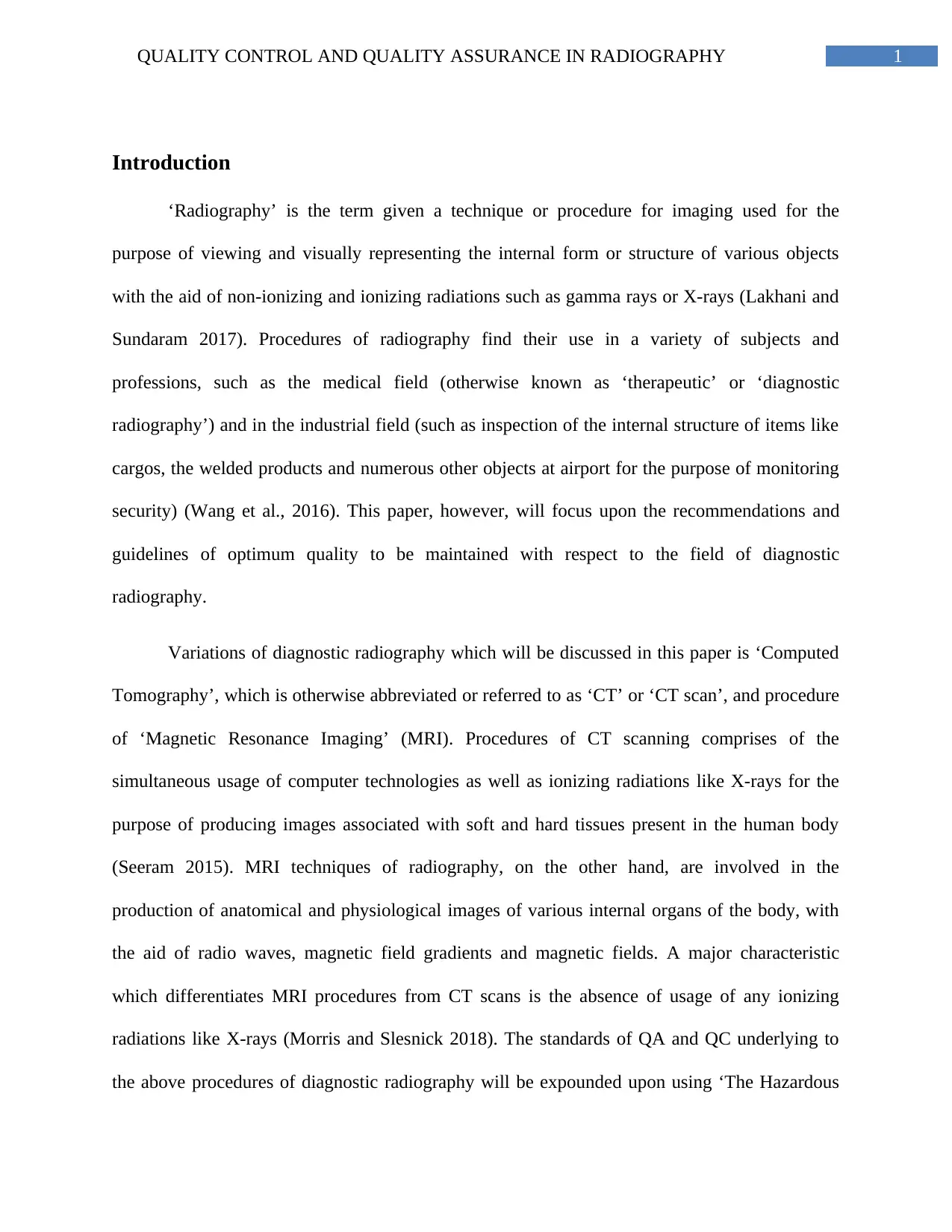
Introduction
‘Radiography’ is the term given a technique or procedure for imaging used for the
purpose of viewing and visually representing the internal form or structure of various objects
with the aid of non-ionizing and ionizing radiations such as gamma rays or X-rays (Lakhani and
Sundaram 2017). Procedures of radiography find their use in a variety of subjects and
professions, such as the medical field (otherwise known as ‘therapeutic’ or ‘diagnostic
radiography’) and in the industrial field (such as inspection of the internal structure of items like
cargos, the welded products and numerous other objects at airport for the purpose of monitoring
security) (Wang et al., 2016). This paper, however, will focus upon the recommendations and
guidelines of optimum quality to be maintained with respect to the field of diagnostic
radiography.
Variations of diagnostic radiography which will be discussed in this paper is ‘Computed
Tomography’, which is otherwise abbreviated or referred to as ‘CT’ or ‘CT scan’, and procedure
of ‘Magnetic Resonance Imaging’ (MRI). Procedures of CT scanning comprises of the
simultaneous usage of computer technologies as well as ionizing radiations like X-rays for the
purpose of producing images associated with soft and hard tissues present in the human body
(Seeram 2015). MRI techniques of radiography, on the other hand, are involved in the
production of anatomical and physiological images of various internal organs of the body, with
the aid of radio waves, magnetic field gradients and magnetic fields. A major characteristic
which differentiates MRI procedures from CT scans is the absence of usage of any ionizing
radiations like X-rays (Morris and Slesnick 2018). The standards of QA and QC underlying to
the above procedures of diagnostic radiography will be expounded upon using ‘The Hazardous
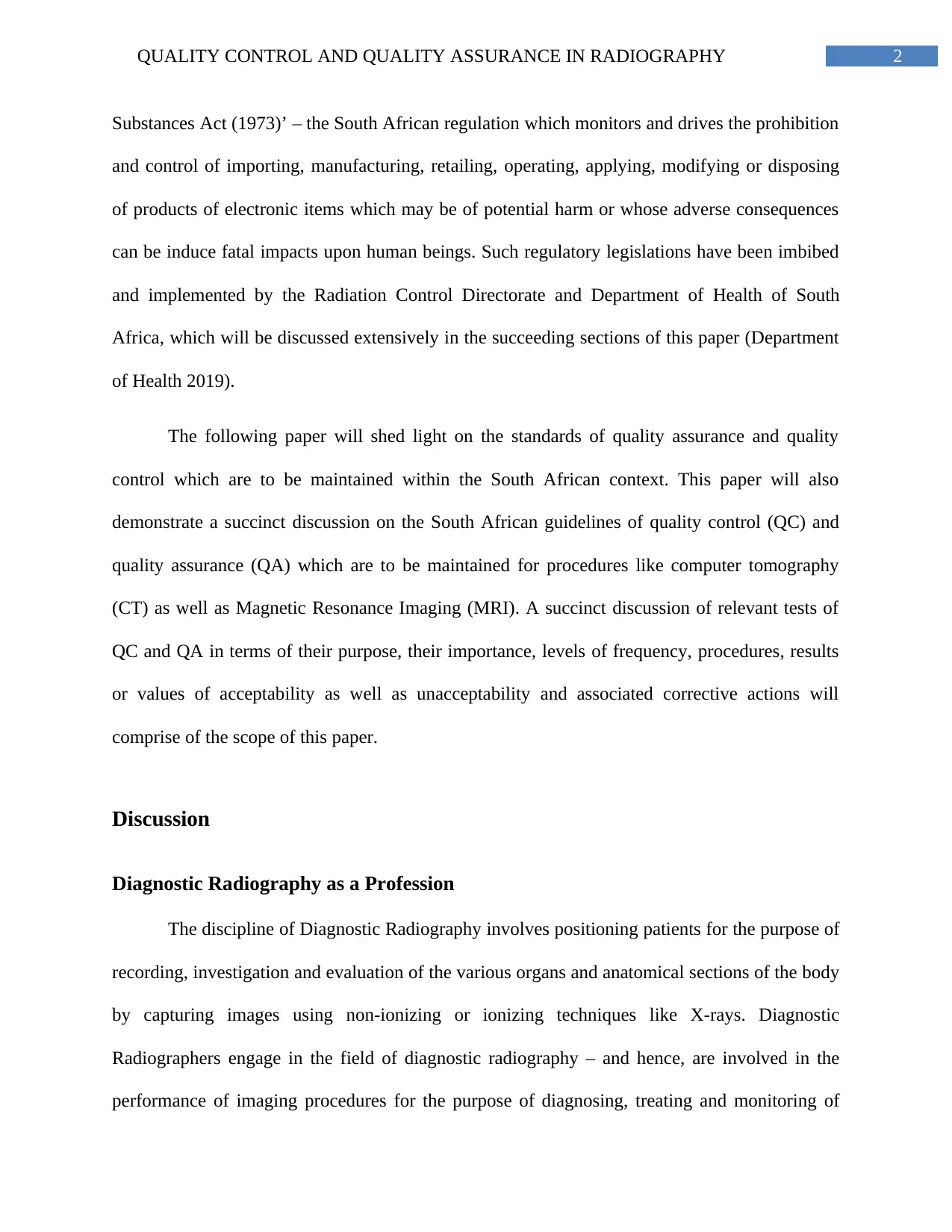
Substances Act (1973)’ – the South African regulation which monitors and drives the prohibition
and control of importing, manufacturing, retailing, operating, applying, modifying or disposing
of products of electronic items which may be of potential harm or whose adverse consequences
can be induce fatal impacts upon human beings. Such regulatory legislations have been imbibed
and implemented by the Radiation Control Directorate and Department of Health of South
Africa, which will be discussed extensively in the succeeding sections of this paper (Department
of Health 2019).
The following paper will shed light on the standards of quality assurance and quality
control which are to be maintained within the South African context. This paper will also
demonstrate a succinct discussion on the South African guidelines of quality control (QC) and
quality assurance (QA) which are to be maintained for procedures like computer tomography
(CT) as well as Magnetic Resonance Imaging (MRI). A succinct discussion of relevant tests of
QC and QA in terms of their purpose, their importance, levels of frequency, procedures, results
or values of acceptability as well as unacceptability and associated corrective actions will
comprise of the scope of this paper.
Discussion
Diagnostic Radiography as a Profession
The discipline of Diagnostic Radiography involves positioning patients for the purpose of
recording, investigation and evaluation of the various organs and anatomical sections of the body
by capturing images using non-ionizing or ionizing techniques like X-rays. Diagnostic
Radiographers engage in the field of diagnostic radiography – and hence, are involved in the
performance of imaging procedures for the purpose of diagnosing, treating and monitoring of
⊘ This is a preview!⊘
Do you want full access?
Subscribe today to unlock all pages.

Trusted by 1+ million students worldwide
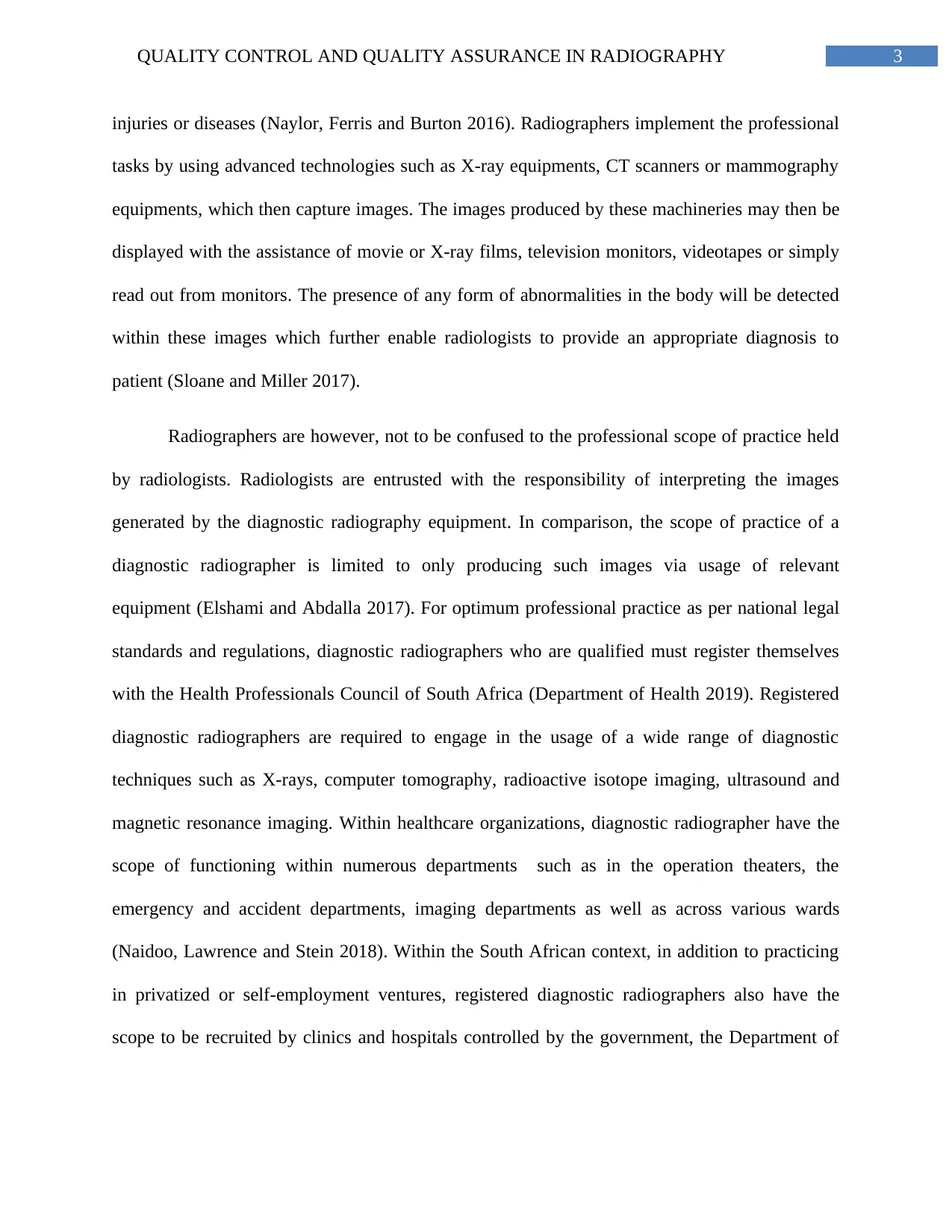
injuries or diseases (Naylor, Ferris and Burton 2016). Radiographers implement the professional
tasks by using advanced technologies such as X-ray equipments, CT scanners or mammography
equipments, which then capture images. The images produced by these machineries may then be
displayed with the assistance of movie or X-ray films, television monitors, videotapes or simply
read out from monitors. The presence of any form of abnormalities in the body will be detected
within these images which further enable radiologists to provide an appropriate diagnosis to
patient (Sloane and Miller 2017).
Radiographers are however, not to be confused to the professional scope of practice held
by radiologists. Radiologists are entrusted with the responsibility of interpreting the images
generated by the diagnostic radiography equipment. In comparison, the scope of practice of a
diagnostic radiographer is limited to only producing such images via usage of relevant
equipment (Elshami and Abdalla 2017). For optimum professional practice as per national legal
standards and regulations, diagnostic radiographers who are qualified must register themselves
with the Health Professionals Council of South Africa (Department of Health 2019). Registered
diagnostic radiographers are required to engage in the usage of a wide range of diagnostic
techniques such as X-rays, computer tomography, radioactive isotope imaging, ultrasound and
magnetic resonance imaging. Within healthcare organizations, diagnostic radiographer have the
scope of functioning within numerous departments such as in the operation theaters, the
emergency and accident departments, imaging departments as well as across various wards
(Naidoo, Lawrence and Stein 2018). Within the South African context, in addition to practicing
in privatized or self-employment ventures, registered diagnostic radiographers also have the
scope to be recruited by clinics and hospitals controlled by the government, the Department of
Paraphrase This Document
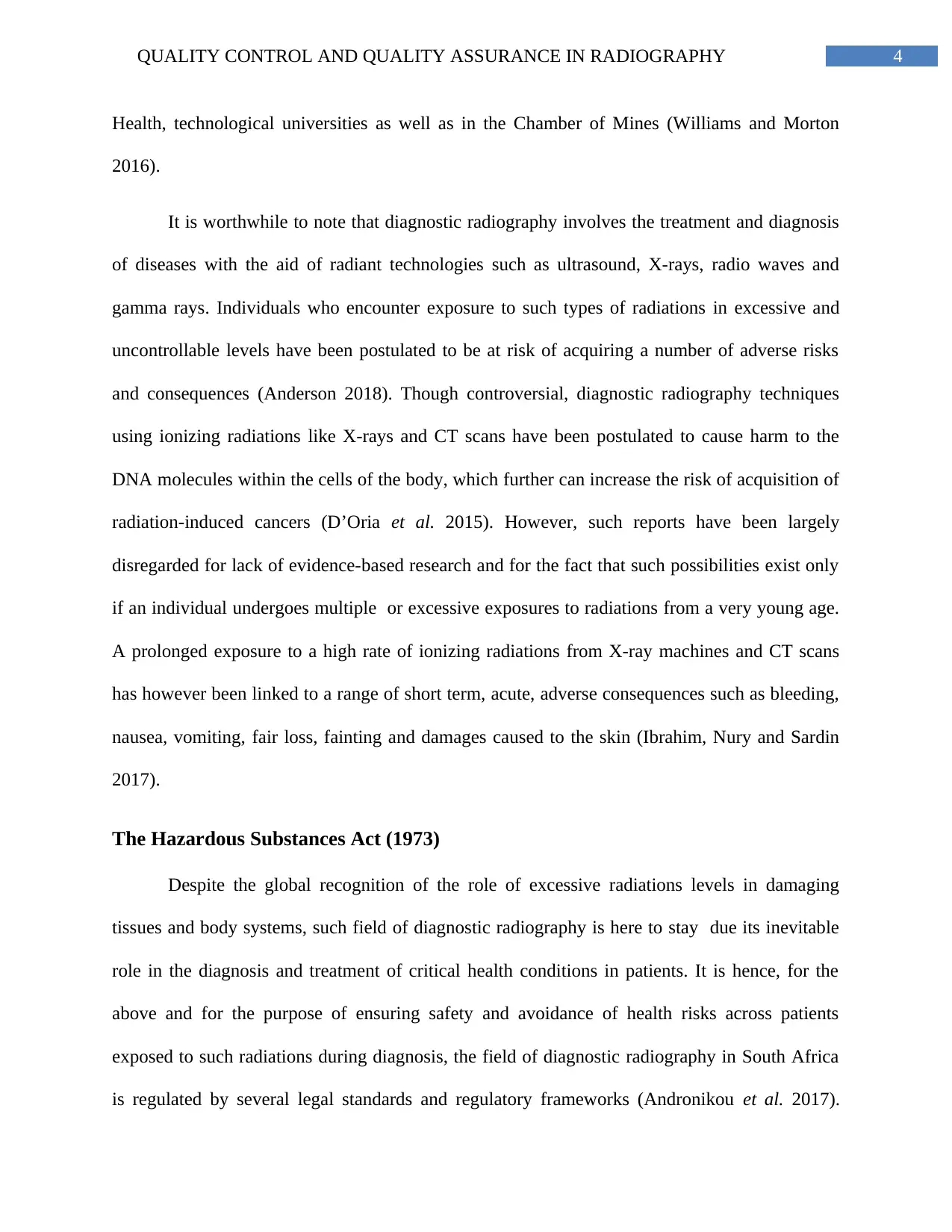
Health, technological universities as well as in the Chamber of Mines (Williams and Morton
2016).
It is worthwhile to note that diagnostic radiography involves the treatment and diagnosis
of diseases with the aid of radiant technologies such as ultrasound, X-rays, radio waves and
gamma rays. Individuals who encounter exposure to such types of radiations in excessive and
uncontrollable levels have been postulated to be at risk of acquiring a number of adverse risks
and consequences (Anderson 2018). Though controversial, diagnostic radiography techniques
using ionizing radiations like X-rays and CT scans have been postulated to cause harm to the
DNA molecules within the cells of the body, which further can increase the risk of acquisition of
radiation-induced cancers (D’Oria et al. 2015). However, such reports have been largely
disregarded for lack of evidence-based research and for the fact that such possibilities exist only
if an individual undergoes multiple or excessive exposures to radiations from a very young age.
A prolonged exposure to a high rate of ionizing radiations from X-ray machines and CT scans
has however been linked to a range of short term, acute, adverse consequences such as bleeding,
nausea, vomiting, fair loss, fainting and damages caused to the skin (Ibrahim, Nury and Sardin
2017).
The Hazardous Substances Act (1973)
Despite the global recognition of the role of excessive radiations levels in damaging
tissues and body systems, such field of diagnostic radiography is here to stay due its inevitable
role in the diagnosis and treatment of critical health conditions in patients. It is hence, for the
above and for the purpose of ensuring safety and avoidance of health risks across patients
exposed to such radiations during diagnosis, the field of diagnostic radiography in South Africa
is regulated by several legal standards and regulatory frameworks (Andronikou et al. 2017).
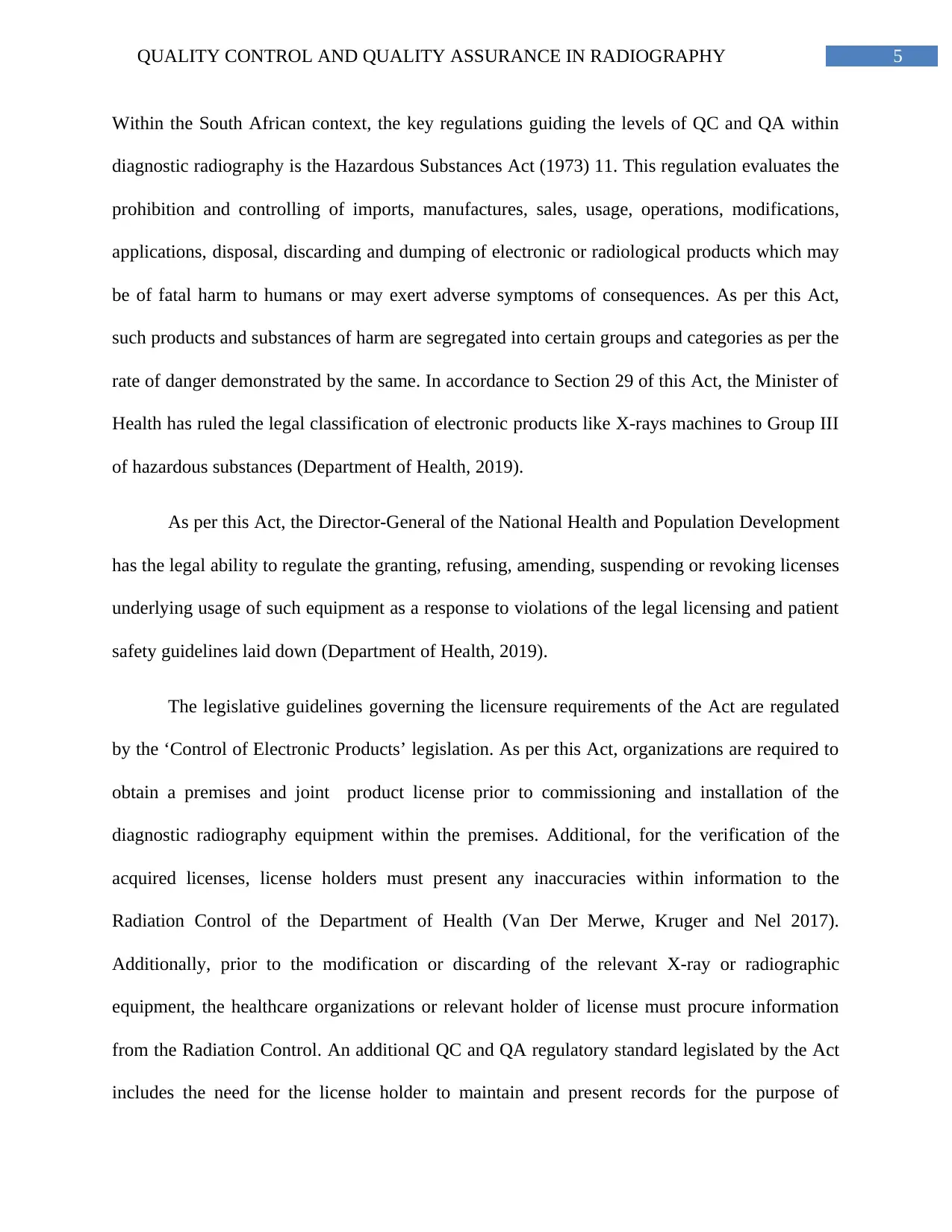
Within the South African context, the key regulations guiding the levels of QC and QA within
diagnostic radiography is the Hazardous Substances Act (1973) 11. This regulation evaluates the
prohibition and controlling of imports, manufactures, sales, usage, operations, modifications,
applications, disposal, discarding and dumping of electronic or radiological products which may
be of fatal harm to humans or may exert adverse symptoms of consequences. As per this Act,
such products and substances of harm are segregated into certain groups and categories as per the
rate of danger demonstrated by the same. In accordance to Section 29 of this Act, the Minister of
Health has ruled the legal classification of electronic products like X-rays machines to Group III
of hazardous substances (Department of Health, 2019).
As per this Act, the Director-General of the National Health and Population Development
has the legal ability to regulate the granting, refusing, amending, suspending or revoking licenses
underlying usage of such equipment as a response to violations of the legal licensing and patient
safety guidelines laid down (Department of Health, 2019).
The legislative guidelines governing the licensure requirements of the Act are regulated
by the ‘Control of Electronic Products’ legislation. As per this Act, organizations are required to
obtain a premises and joint product license prior to commissioning and installation of the
diagnostic radiography equipment within the premises. Additional, for the verification of the
acquired licenses, license holders must present any inaccuracies within information to the
Radiation Control of the Department of Health (Van Der Merwe, Kruger and Nel 2017).
Additionally, prior to the modification or discarding of the relevant X-ray or radiographic
equipment, the healthcare organizations or relevant holder of license must procure information
from the Radiation Control. An additional QC and QA regulatory standard legislated by the Act
includes the need for the license holder to maintain and present records for the purpose of
⊘ This is a preview!⊘
Do you want full access?
Subscribe today to unlock all pages.

Trusted by 1+ million students worldwide
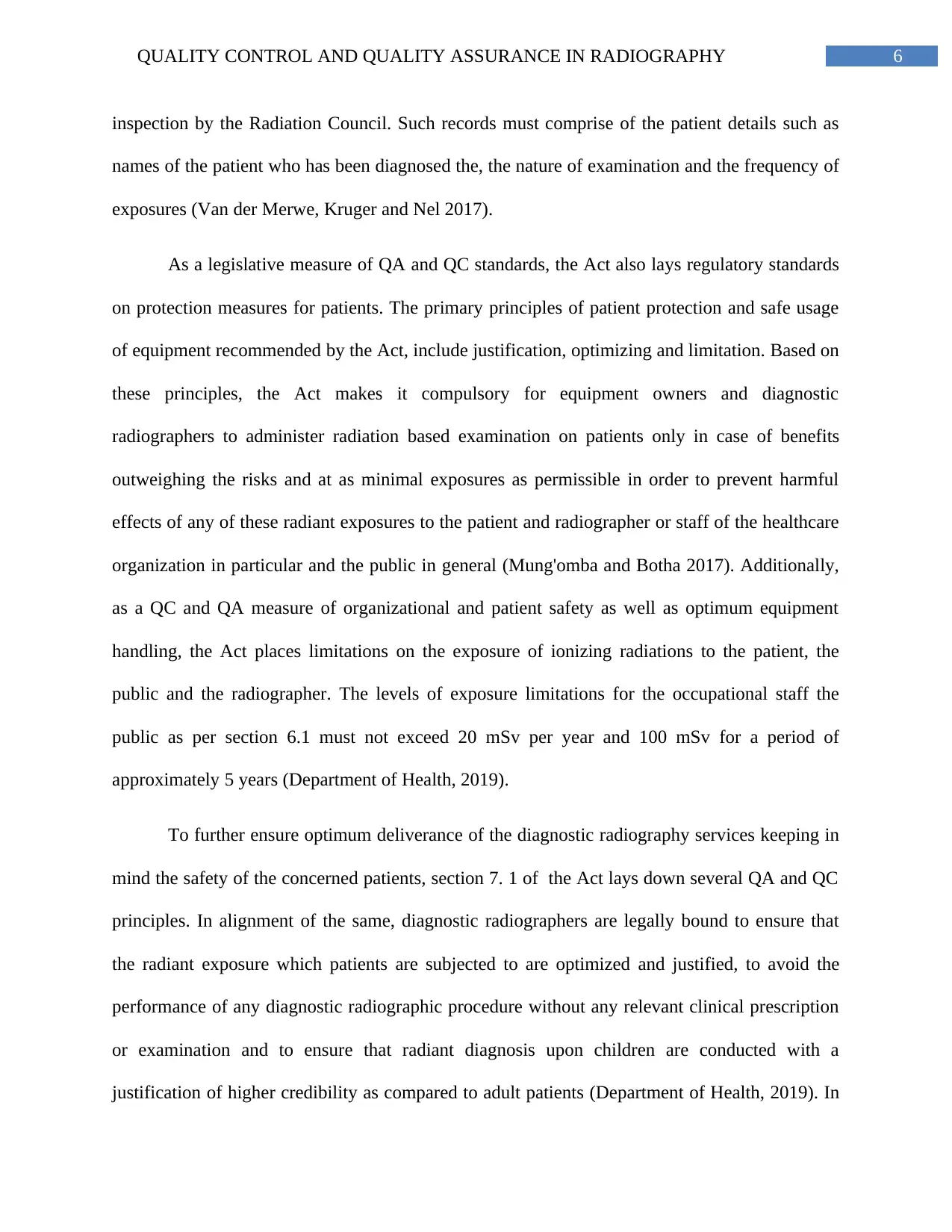
inspection by the Radiation Council. Such records must comprise of the patient details such as
names of the patient who has been diagnosed the, the nature of examination and the frequency of
exposures (Van der Merwe, Kruger and Nel 2017).
As a legislative measure of QA and QC standards, the Act also lays regulatory standards
on protection measures for patients. The primary principles of patient protection and safe usage
of equipment recommended by the Act, include justification, optimizing and limitation. Based on
these principles, the Act makes it compulsory for equipment owners and diagnostic
radiographers to administer radiation based examination on patients only in case of benefits
outweighing the risks and at as minimal exposures as permissible in order to prevent harmful
effects of any of these radiant exposures to the patient and radiographer or staff of the healthcare
organization in particular and the public in general (Mung'omba and Botha 2017). Additionally,
as a QC and QA measure of organizational and patient safety as well as optimum equipment
handling, the Act places limitations on the exposure of ionizing radiations to the patient, the
public and the radiographer. The levels of exposure limitations for the occupational staff the
public as per section 6.1 must not exceed 20 mSv per year and 100 mSv for a period of
approximately 5 years (Department of Health, 2019).
To further ensure optimum deliverance of the diagnostic radiography services keeping in
mind the safety of the concerned patients, section 7. 1 of the Act lays down several QA and QC
principles. In alignment of the same, diagnostic radiographers are legally bound to ensure that
the radiant exposure which patients are subjected to are optimized and justified, to avoid the
performance of any diagnostic radiographic procedure without any relevant clinical prescription
or examination and to ensure that radiant diagnosis upon children are conducted with a
justification of higher credibility as compared to adult patients (Department of Health, 2019). In
Paraphrase This Document

addition to the above, the Act also necessitates the usage of diagnostic reference levels (DRLs)
by the relevant healthcare organizations and diagnostic radiographers holding licenses for the
same. Documents outlining DRLs are necessary since they serve us recommendations of
radiation limits to be maintain for patients within a standard health condition and anthropometric
measurement and are thus, regarded as professional and clinical diagnostic service of good
quality (Kabongo, Nel and Pitcher 2015).
In addition to Section 7.1 of the Act which necessitates the need to perform radiation
based diagnostic examinations only by a registered and trained health professional as well as
medical practitioner, sections7.2 to 7.8 of the Act also dictates QA and QC standards to be
followed by diagnostic radiographers during the examination of patients who are pregnant or are
children as well as regarding the optimum reporting of radiation based injuries and usage of
protective clothing during examinations (Department of Health, 2019). As per Section 7.2 and
7.3 of the Act, diagnostic radiography performed on patients who are pregnant or are of healthy
and sound reproductive capacity must be strictly based on justified clinical examinations, must
be restricted to minimal exposure levels and must strictly adhere to higher kVp levels to ensure
rapid production of images with minimal radiation exposure (Makanjee and Engel-Hills 2018).
Similarly, as per section 7.4 of the Act, diagnostic radiographers during the radiant examination
of patients with the pediatric community must strictly be avoided if a highly strong and credible
clinical justification is absent. This is due to the fact that children, due to their prolonged life
expectancy and sensitive stage of continuous development are highly susceptible in acquiring the
adverse chronic consequences of continuous, frequent and high exposure to radiations
(Department of Health, 2019). To further ensure that the general public are protected from the
harmful health impacts of radiations due to equipment emitting ionizing radiations, section 7.5 of
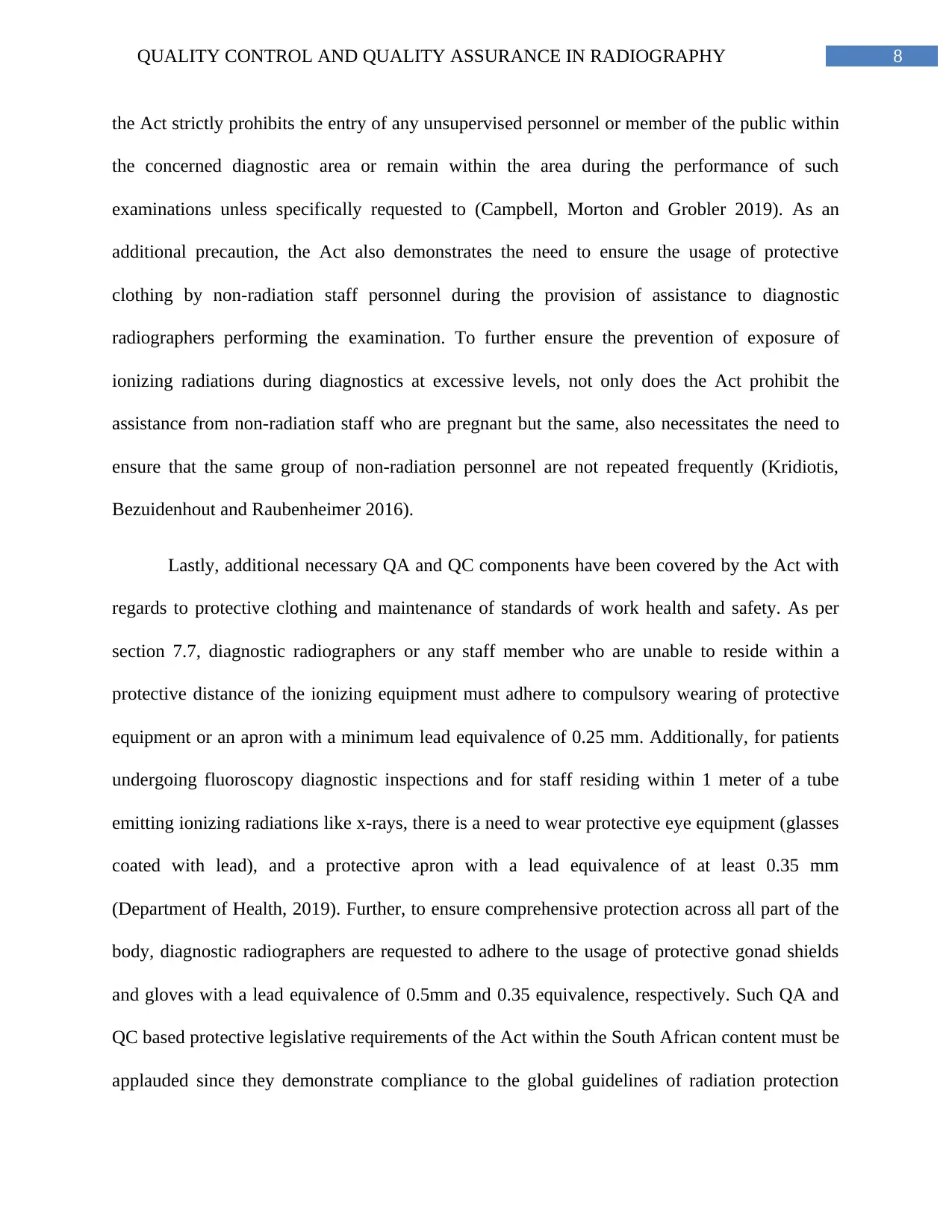
the Act strictly prohibits the entry of any unsupervised personnel or member of the public within
the concerned diagnostic area or remain within the area during the performance of such
examinations unless specifically requested to (Campbell, Morton and Grobler 2019). As an
additional precaution, the Act also demonstrates the need to ensure the usage of protective
clothing by non-radiation staff personnel during the provision of assistance to diagnostic
radiographers performing the examination. To further ensure the prevention of exposure of
ionizing radiations during diagnostics at excessive levels, not only does the Act prohibit the
assistance from non-radiation staff who are pregnant but the same, also necessitates the need to
ensure that the same group of non-radiation personnel are not repeated frequently (Kridiotis,
Bezuidenhout and Raubenheimer 2016).
Lastly, additional necessary QA and QC components have been covered by the Act with
regards to protective clothing and maintenance of standards of work health and safety. As per
section 7.7, diagnostic radiographers or any staff member who are unable to reside within a
protective distance of the ionizing equipment must adhere to compulsory wearing of protective
equipment or an apron with a minimum lead equivalence of 0.25 mm. Additionally, for patients
undergoing fluoroscopy diagnostic inspections and for staff residing within 1 meter of a tube
emitting ionizing radiations like x-rays, there is a need to wear protective eye equipment (glasses
coated with lead), and a protective apron with a lead equivalence of at least 0.35 mm
(Department of Health, 2019). Further, to ensure comprehensive protection across all part of the
body, diagnostic radiographers are requested to adhere to the usage of protective gonad shields
and gloves with a lead equivalence of 0.5mm and 0.35 equivalence, respectively. Such QA and
QC based protective legislative requirements of the Act within the South African content must be
applauded since they demonstrate compliance to the global guidelines of radiation protection
⊘ This is a preview!⊘
Do you want full access?
Subscribe today to unlock all pages.

Trusted by 1+ million students worldwide
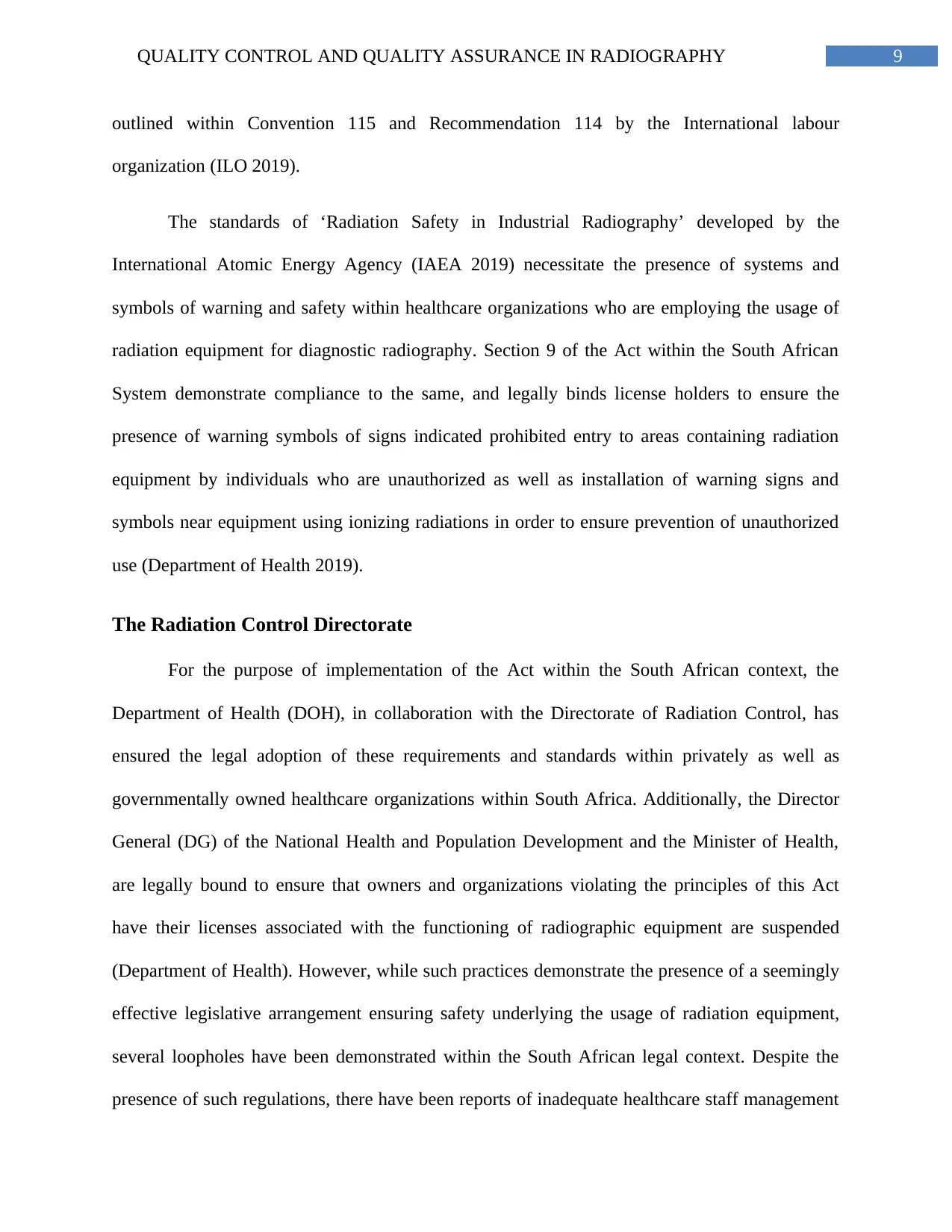
outlined within Convention 115 and Recommendation 114 by the International labour
organization (ILO 2019).
The standards of ‘Radiation Safety in Industrial Radiography’ developed by the
International Atomic Energy Agency (IAEA 2019) necessitate the presence of systems and
symbols of warning and safety within healthcare organizations who are employing the usage of
radiation equipment for diagnostic radiography. Section 9 of the Act within the South African
System demonstrate compliance to the same, and legally binds license holders to ensure the
presence of warning symbols of signs indicated prohibited entry to areas containing radiation
equipment by individuals who are unauthorized as well as installation of warning signs and
symbols near equipment using ionizing radiations in order to ensure prevention of unauthorized
use (Department of Health 2019).
The Radiation Control Directorate
For the purpose of implementation of the Act within the South African context, the
Department of Health (DOH), in collaboration with the Directorate of Radiation Control, has
ensured the legal adoption of these requirements and standards within privately as well as
governmentally owned healthcare organizations within South Africa. Additionally, the Director
General (DG) of the National Health and Population Development and the Minister of Health,
are legally bound to ensure that owners and organizations violating the principles of this Act
have their licenses associated with the functioning of radiographic equipment are suspended
(Department of Health). However, while such practices demonstrate the presence of a seemingly
effective legislative arrangement ensuring safety underlying the usage of radiation equipment,
several loopholes have been demonstrated within the South African legal context. Despite the
presence of such regulations, there have been reports of inadequate healthcare staff management
Paraphrase This Document

and levels of staff to patient ratios, high rates of vacancies, lack of recent data in healthcare
organizations on the installation and usage of radiation equipment and the absence of an
occupational safe and sound radiation protective procedures and regulatory, quality control
bodies within healthcare organizations (Herbst and Fick 2012).
Further, a major limitation of the legal implementation of this Act is the lack of valid
consultation process established by the government which can regulate compliance to radiation
equipment licensures. Indeed, as observed within governmental online sources, there remains
merely an annexure comprising of licensing requirements to be followed without any
governmentally approved details on the procedures to be followed to legally ensure the same.
This demonstrates a lack of consistency and prevalence of ambiguity across South African
governmental and healthcare organizations regarding radiation protection and licensing
procedures (Makanjee and Engel-Hills 2018).
Another key loophole which has been demonstrated by the Act, is the lack of any
precautions to be maintained in the case of the diagnosis of patients who are elderly. It has been
estimated that, in addition to children, diagnostic radiographers must undertaken strict
precautions when attending to individuals within the geriatric population using ionizing
radiations (Chipere and Nkosi 2019). This is due to the higher sensitivity and susceptibility of
acquiring the harmful chronic conditions as a result of prolonged radiation exposure possessed
by individuals who are elderly. Additionally, the Act dictates the need for diagnostic
radiographers to perform radiation based diagnostic procedures only in the presence of a clinical
prescription which is strongly justifies the need to conduct radiant examination (Department of
Health 2019). However, despite such precautions, the Act does not demonstrate any specific
information on the details of clinical prescriptions or examinations which may be considered as a
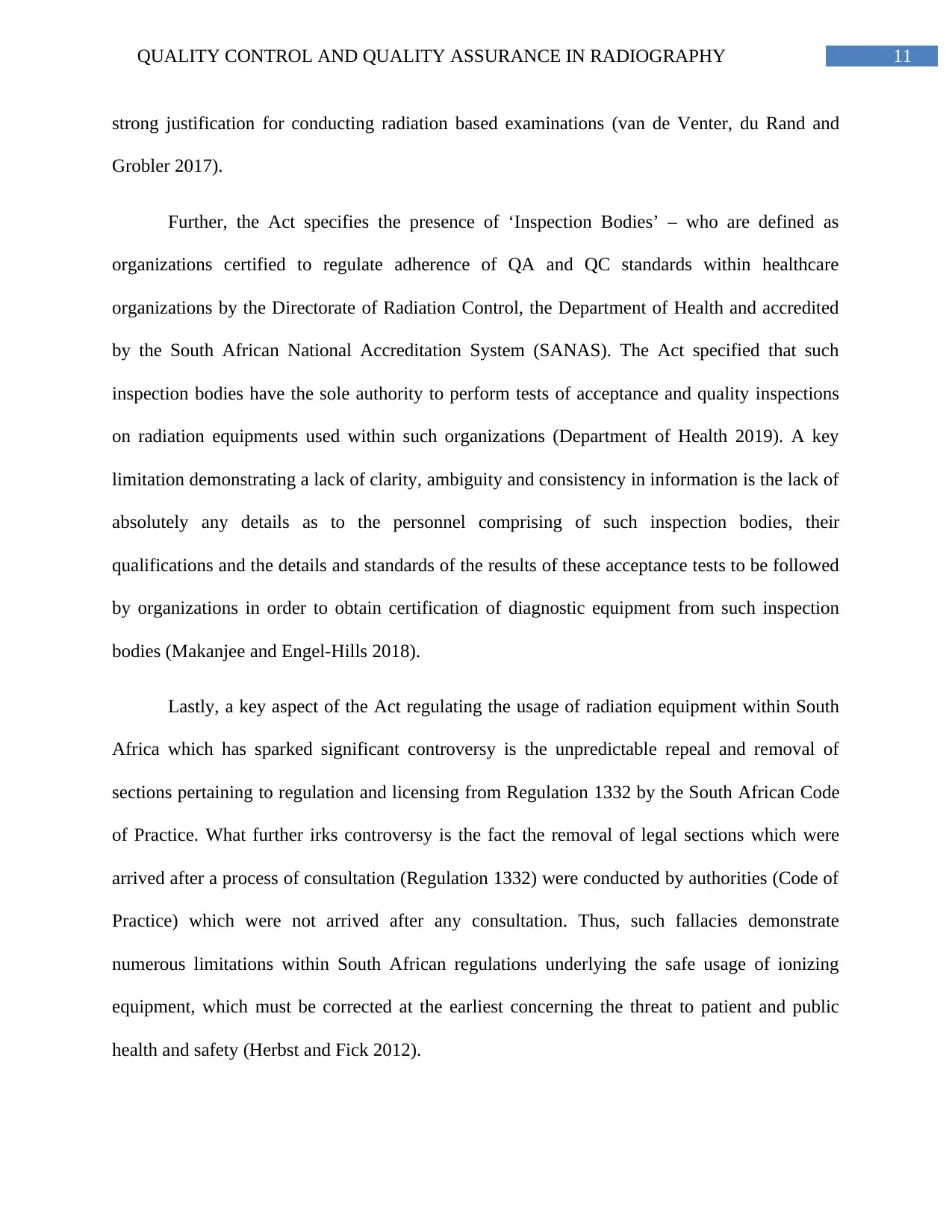
strong justification for conducting radiation based examinations (van de Venter, du Rand and
Grobler 2017).
Further, the Act specifies the presence of ‘Inspection Bodies’ – who are defined as
organizations certified to regulate adherence of QA and QC standards within healthcare
organizations by the Directorate of Radiation Control, the Department of Health and accredited
by the South African National Accreditation System (SANAS). The Act specified that such
inspection bodies have the sole authority to perform tests of acceptance and quality inspections
on radiation equipments used within such organizations (Department of Health 2019). A key
limitation demonstrating a lack of clarity, ambiguity and consistency in information is the lack of
absolutely any details as to the personnel comprising of such inspection bodies, their
qualifications and the details and standards of the results of these acceptance tests to be followed
by organizations in order to obtain certification of diagnostic equipment from such inspection
bodies (Makanjee and Engel-Hills 2018).
Lastly, a key aspect of the Act regulating the usage of radiation equipment within South
Africa which has sparked significant controversy is the unpredictable repeal and removal of
sections pertaining to regulation and licensing from Regulation 1332 by the South African Code
of Practice. What further irks controversy is the fact the removal of legal sections which were
arrived after a process of consultation (Regulation 1332) were conducted by authorities (Code of
Practice) which were not arrived after any consultation. Thus, such fallacies demonstrate
numerous limitations within South African regulations underlying the safe usage of ionizing
equipment, which must be corrected at the earliest concerning the threat to patient and public
health and safety (Herbst and Fick 2012).
⊘ This is a preview!⊘
Do you want full access?
Subscribe today to unlock all pages.

Trusted by 1+ million students worldwide
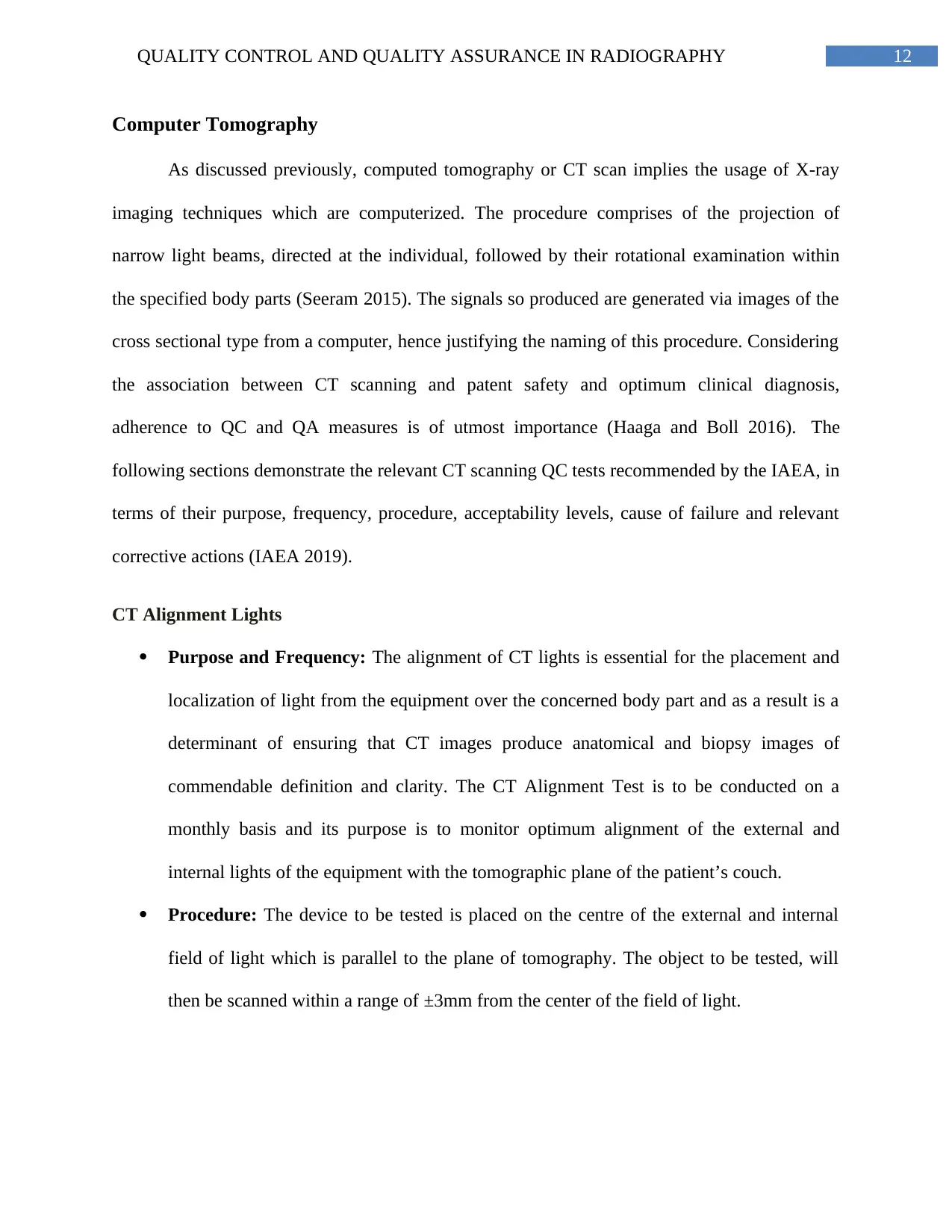
Computer Tomography
As discussed previously, computed tomography or CT scan implies the usage of X-ray
imaging techniques which are computerized. The procedure comprises of the projection of
narrow light beams, directed at the individual, followed by their rotational examination within
the specified body parts (Seeram 2015). The signals so produced are generated via images of the
cross sectional type from a computer, hence justifying the naming of this procedure. Considering
the association between CT scanning and patent safety and optimum clinical diagnosis,
adherence to QC and QA measures is of utmost importance (Haaga and Boll 2016). The
following sections demonstrate the relevant CT scanning QC tests recommended by the IAEA, in
terms of their purpose, frequency, procedure, acceptability levels, cause of failure and relevant
corrective actions (IAEA 2019).
CT Alignment Lights
Purpose and Frequency: The alignment of CT lights is essential for the placement and
localization of light from the equipment over the concerned body part and as a result is a
determinant of ensuring that CT images produce anatomical and biopsy images of
commendable definition and clarity. The CT Alignment Test is to be conducted on a
monthly basis and its purpose is to monitor optimum alignment of the external and
internal lights of the equipment with the tomographic plane of the patient’s couch.
Procedure: The device to be tested is placed on the centre of the external and internal
field of light which is parallel to the plane of tomography. The object to be tested, will
then be scanned within a range of ±3mm from the center of the field of light.
Paraphrase This Document
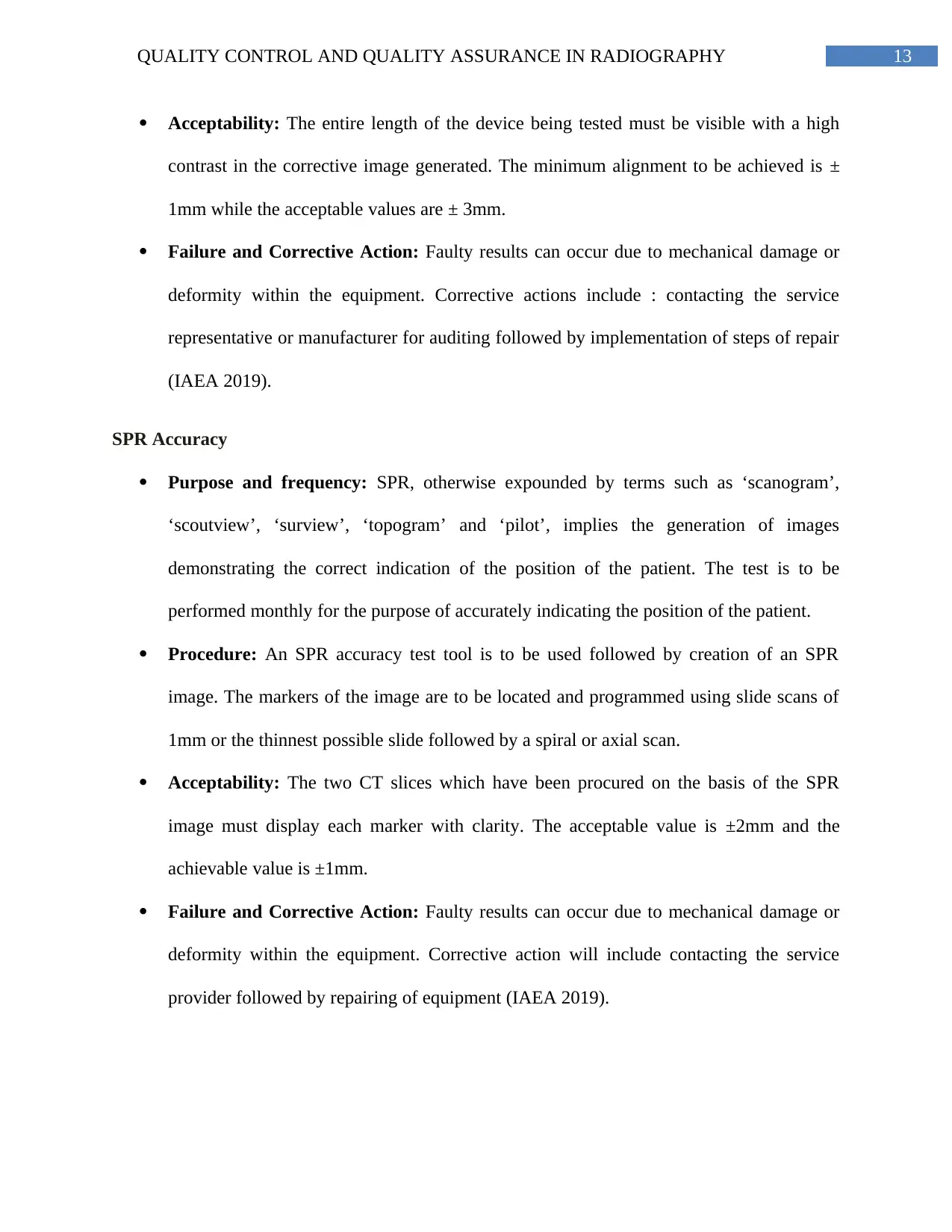
Acceptability: The entire length of the device being tested must be visible with a high
contrast in the corrective image generated. The minimum alignment to be achieved is ±
1mm while the acceptable values are ± 3mm.
Failure and Corrective Action: Faulty results can occur due to mechanical damage or
deformity within the equipment. Corrective actions include : contacting the service
representative or manufacturer for auditing followed by implementation of steps of repair
(IAEA 2019).
SPR Accuracy
Purpose and frequency: SPR, otherwise expounded by terms such as ‘scanogram’,
‘scoutview’, ‘surview’, ‘topogram’ and ‘pilot’, implies the generation of images
demonstrating the correct indication of the position of the patient. The test is to be
performed monthly for the purpose of accurately indicating the position of the patient.
Procedure: An SPR accuracy test tool is to be used followed by creation of an SPR
image. The markers of the image are to be located and programmed using slide scans of
1mm or the thinnest possible slide followed by a spiral or axial scan.
Acceptability: The two CT slices which have been procured on the basis of the SPR
image must display each marker with clarity. The acceptable value is ±2mm and the
achievable value is ±1mm.
Failure and Corrective Action: Faulty results can occur due to mechanical damage or
deformity within the equipment. Corrective action will include contacting the service
provider followed by repairing of equipment (IAEA 2019).
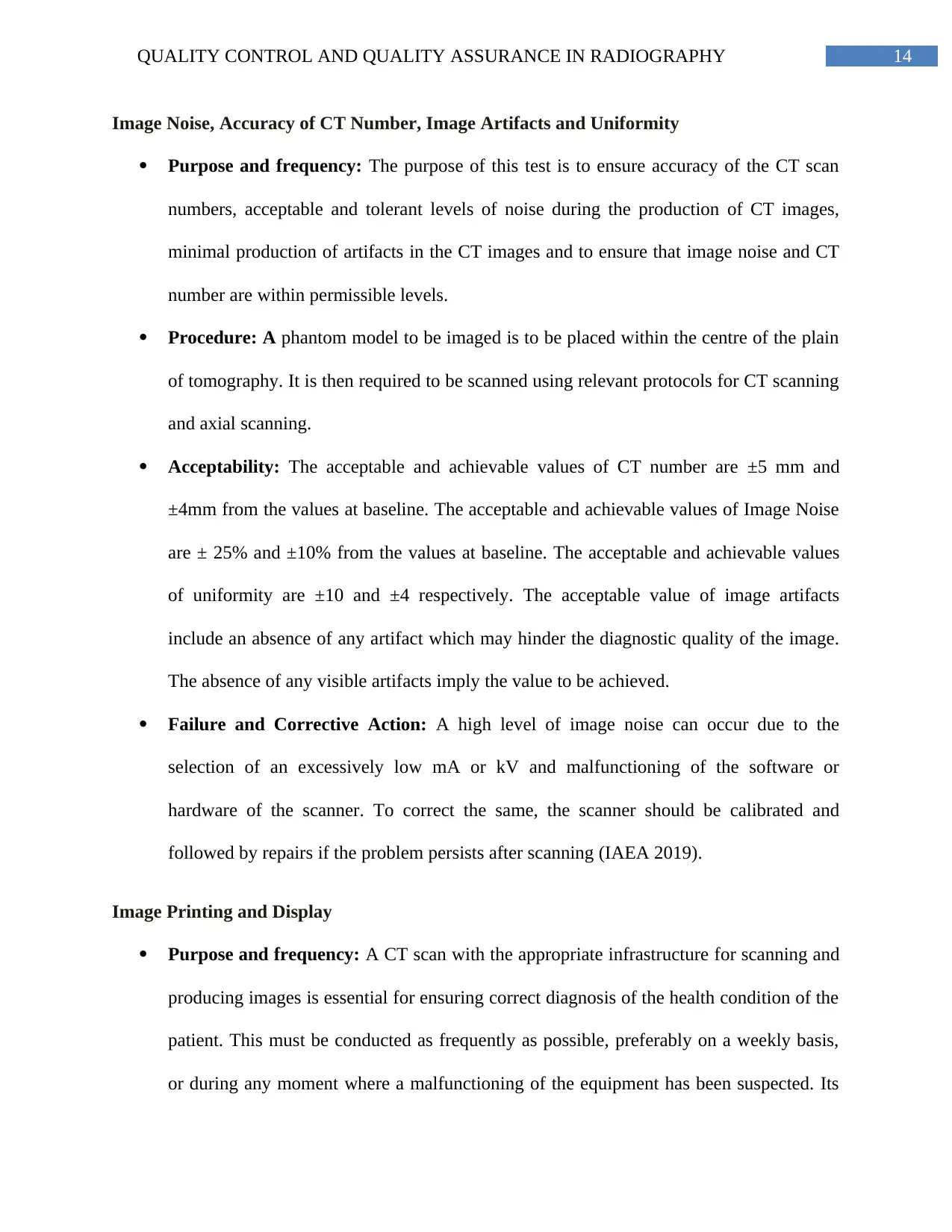
Image Noise, Accuracy of CT Number, Image Artifacts and Uniformity
Purpose and frequency: The purpose of this test is to ensure accuracy of the CT scan
numbers, acceptable and tolerant levels of noise during the production of CT images,
minimal production of artifacts in the CT images and to ensure that image noise and CT
number are within permissible levels.
Procedure: A phantom model to be imaged is to be placed within the centre of the plain
of tomography. It is then required to be scanned using relevant protocols for CT scanning
and axial scanning.
Acceptability: The acceptable and achievable values of CT number are ±5 mm and
±4mm from the values at baseline. The acceptable and achievable values of Image Noise
are ± 25% and ±10% from the values at baseline. The acceptable and achievable values
of uniformity are ±10 and ±4 respectively. The acceptable value of image artifacts
include an absence of any artifact which may hinder the diagnostic quality of the image.
The absence of any visible artifacts imply the value to be achieved.
Failure and Corrective Action: A high level of image noise can occur due to the
selection of an excessively low mA or kV and malfunctioning of the software or
hardware of the scanner. To correct the same, the scanner should be calibrated and
followed by repairs if the problem persists after scanning (IAEA 2019).
Image Printing and Display
Purpose and frequency: A CT scan with the appropriate infrastructure for scanning and
producing images is essential for ensuring correct diagnosis of the health condition of the
patient. This must be conducted as frequently as possible, preferably on a weekly basis,
or during any moment where a malfunctioning of the equipment has been suspected. Its
⊘ This is a preview!⊘
Do you want full access?
Subscribe today to unlock all pages.

Trusted by 1+ million students worldwide
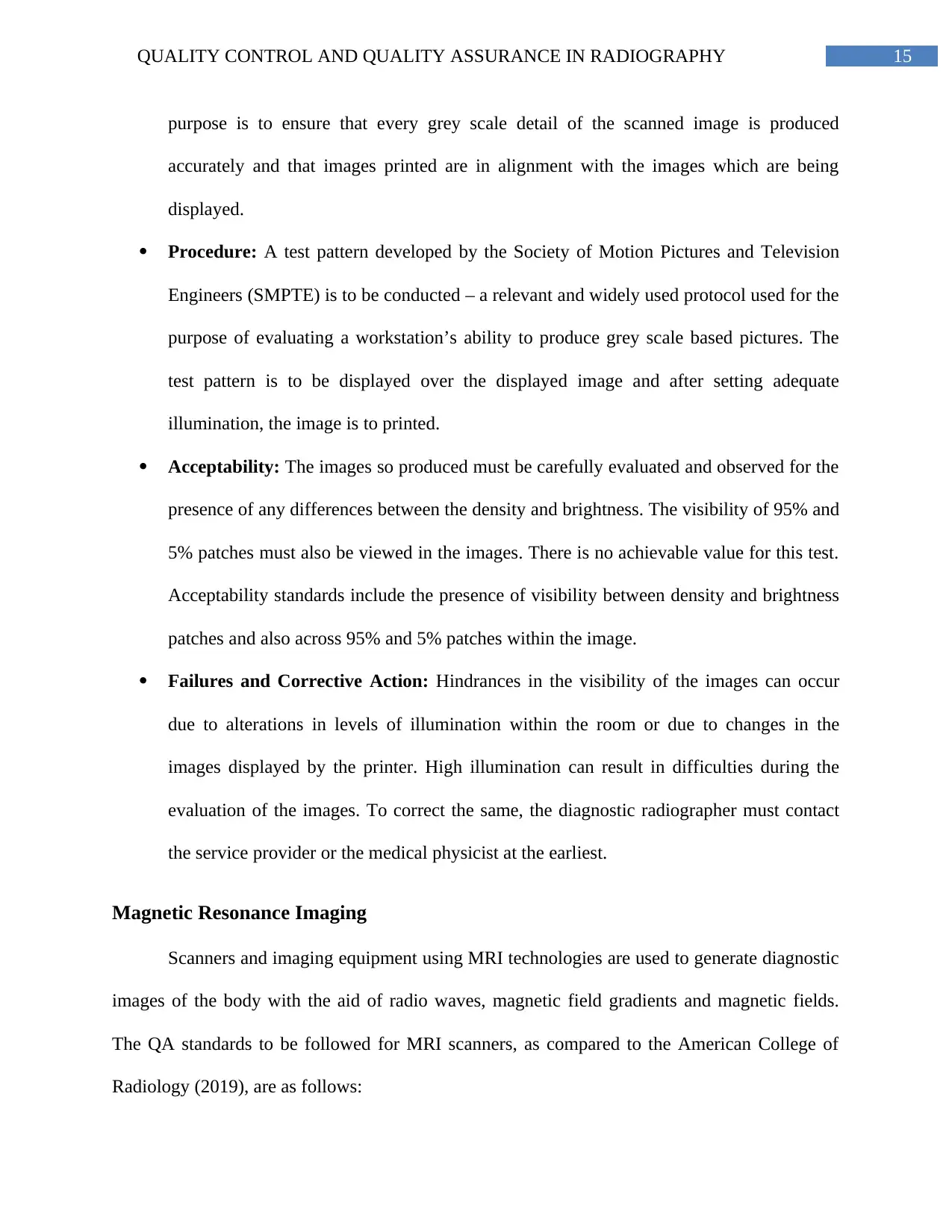
purpose is to ensure that every grey scale detail of the scanned image is produced
accurately and that images printed are in alignment with the images which are being
displayed.
Procedure: A test pattern developed by the Society of Motion Pictures and Television
Engineers (SMPTE) is to be conducted – a relevant and widely used protocol used for the
purpose of evaluating a workstation’s ability to produce grey scale based pictures. The
test pattern is to be displayed over the displayed image and after setting adequate
illumination, the image is to printed.
Acceptability: The images so produced must be carefully evaluated and observed for the
presence of any differences between the density and brightness. The visibility of 95% and
5% patches must also be viewed in the images. There is no achievable value for this test.
Acceptability standards include the presence of visibility between density and brightness
patches and also across 95% and 5% patches within the image.
Failures and Corrective Action: Hindrances in the visibility of the images can occur
due to alterations in levels of illumination within the room or due to changes in the
images displayed by the printer. High illumination can result in difficulties during the
evaluation of the images. To correct the same, the diagnostic radiographer must contact
the service provider or the medical physicist at the earliest.
Magnetic Resonance Imaging
Scanners and imaging equipment using MRI technologies are used to generate diagnostic
images of the body with the aid of radio waves, magnetic field gradients and magnetic fields.
The QA standards to be followed for MRI scanners, as compared to the American College of
Radiology (2019), are as follows:
Paraphrase This Document
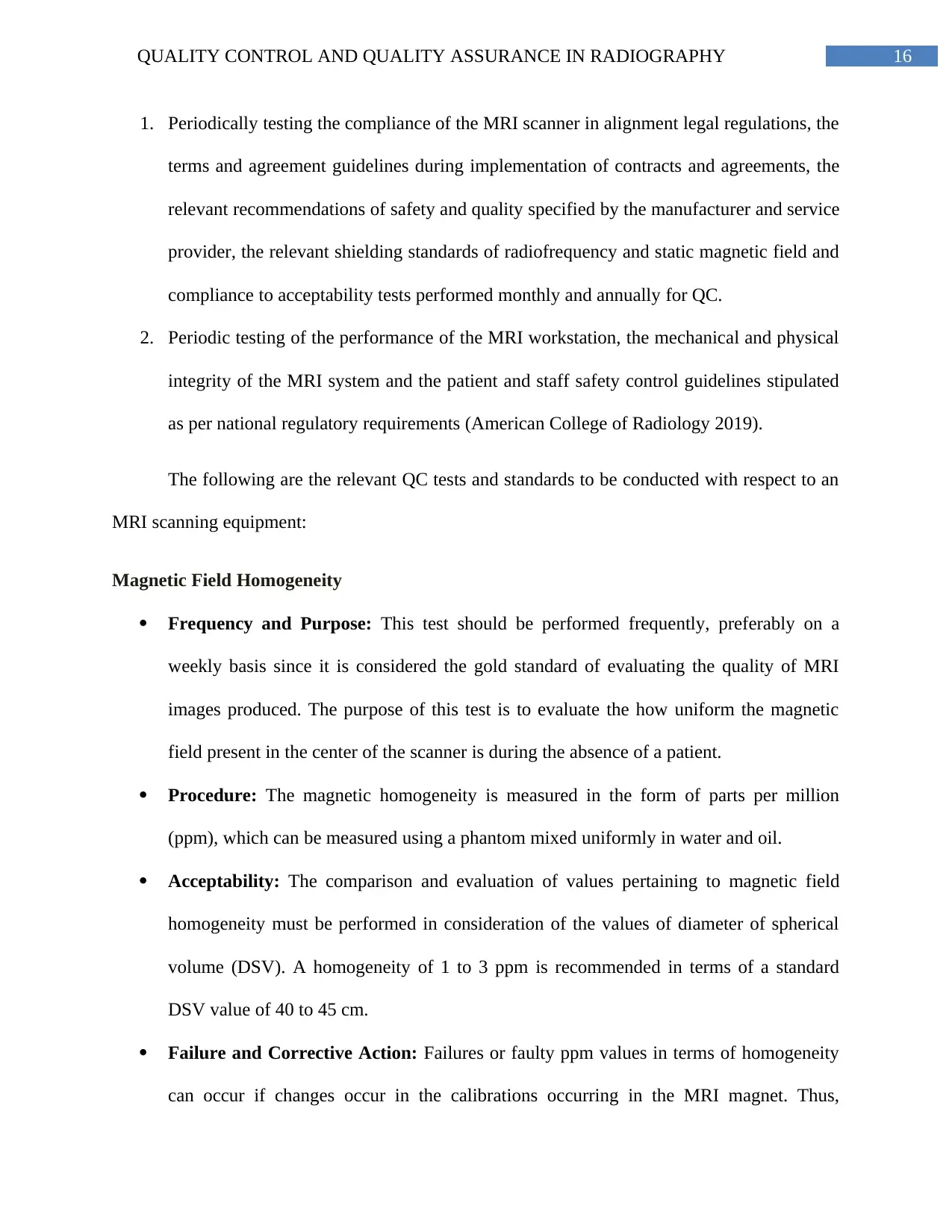
1. Periodically testing the compliance of the MRI scanner in alignment legal regulations, the
terms and agreement guidelines during implementation of contracts and agreements, the
relevant recommendations of safety and quality specified by the manufacturer and service
provider, the relevant shielding standards of radiofrequency and static magnetic field and
compliance to acceptability tests performed monthly and annually for QC.
2. Periodic testing of the performance of the MRI workstation, the mechanical and physical
integrity of the MRI system and the patient and staff safety control guidelines stipulated
as per national regulatory requirements (American College of Radiology 2019).
The following are the relevant QC tests and standards to be conducted with respect to an
MRI scanning equipment:
Magnetic Field Homogeneity
Frequency and Purpose: This test should be performed frequently, preferably on a
weekly basis since it is considered the gold standard of evaluating the quality of MRI
images produced. The purpose of this test is to evaluate the how uniform the magnetic
field present in the center of the scanner is during the absence of a patient.
Procedure: The magnetic homogeneity is measured in the form of parts per million
(ppm), which can be measured using a phantom mixed uniformly in water and oil.
Acceptability: The comparison and evaluation of values pertaining to magnetic field
homogeneity must be performed in consideration of the values of diameter of spherical
volume (DSV). A homogeneity of 1 to 3 ppm is recommended in terms of a standard
DSV value of 40 to 45 cm.
Failure and Corrective Action: Failures or faulty ppm values in terms of homogeneity
can occur if changes occur in the calibrations occurring in the MRI magnet. Thus,
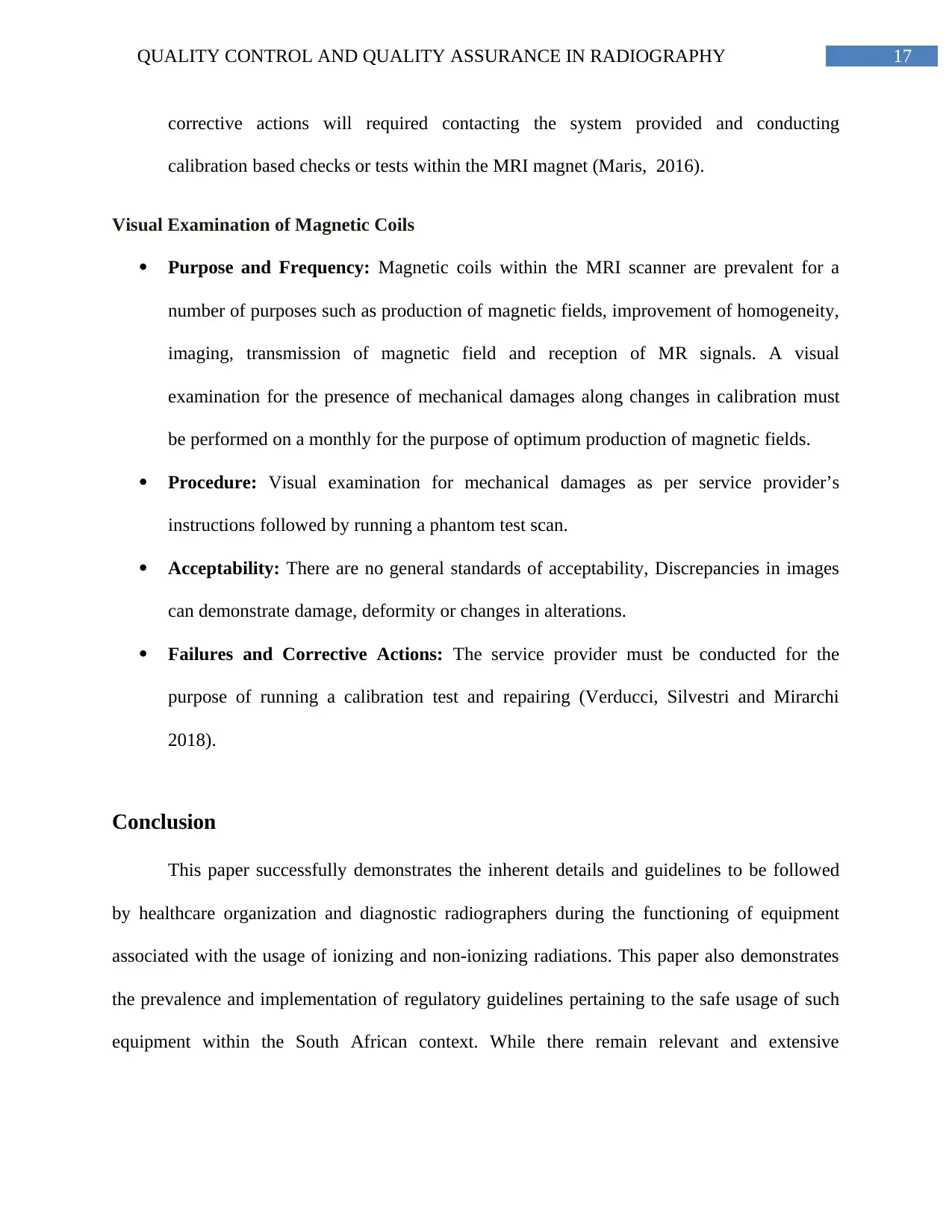
corrective actions will required contacting the system provided and conducting
calibration based checks or tests within the MRI magnet (Maris, 2016).
Visual Examination of Magnetic Coils
Purpose and Frequency: Magnetic coils within the MRI scanner are prevalent for a
number of purposes such as production of magnetic fields, improvement of homogeneity,
imaging, transmission of magnetic field and reception of MR signals. A visual
examination for the presence of mechanical damages along changes in calibration must
be performed on a monthly for the purpose of optimum production of magnetic fields.
Procedure: Visual examination for mechanical damages as per service provider’s
instructions followed by running a phantom test scan.
Acceptability: There are no general standards of acceptability, Discrepancies in images
can demonstrate damage, deformity or changes in alterations.
Failures and Corrective Actions: The service provider must be conducted for the
purpose of running a calibration test and repairing (Verducci, Silvestri and Mirarchi
2018).
Conclusion
This paper successfully demonstrates the inherent details and guidelines to be followed
by healthcare organization and diagnostic radiographers during the functioning of equipment
associated with the usage of ionizing and non-ionizing radiations. This paper also demonstrates
the prevalence and implementation of regulatory guidelines pertaining to the safe usage of such
equipment within the South African context. While there remain relevant and extensive
⊘ This is a preview!⊘
Do you want full access?
Subscribe today to unlock all pages.

Trusted by 1+ million students worldwide
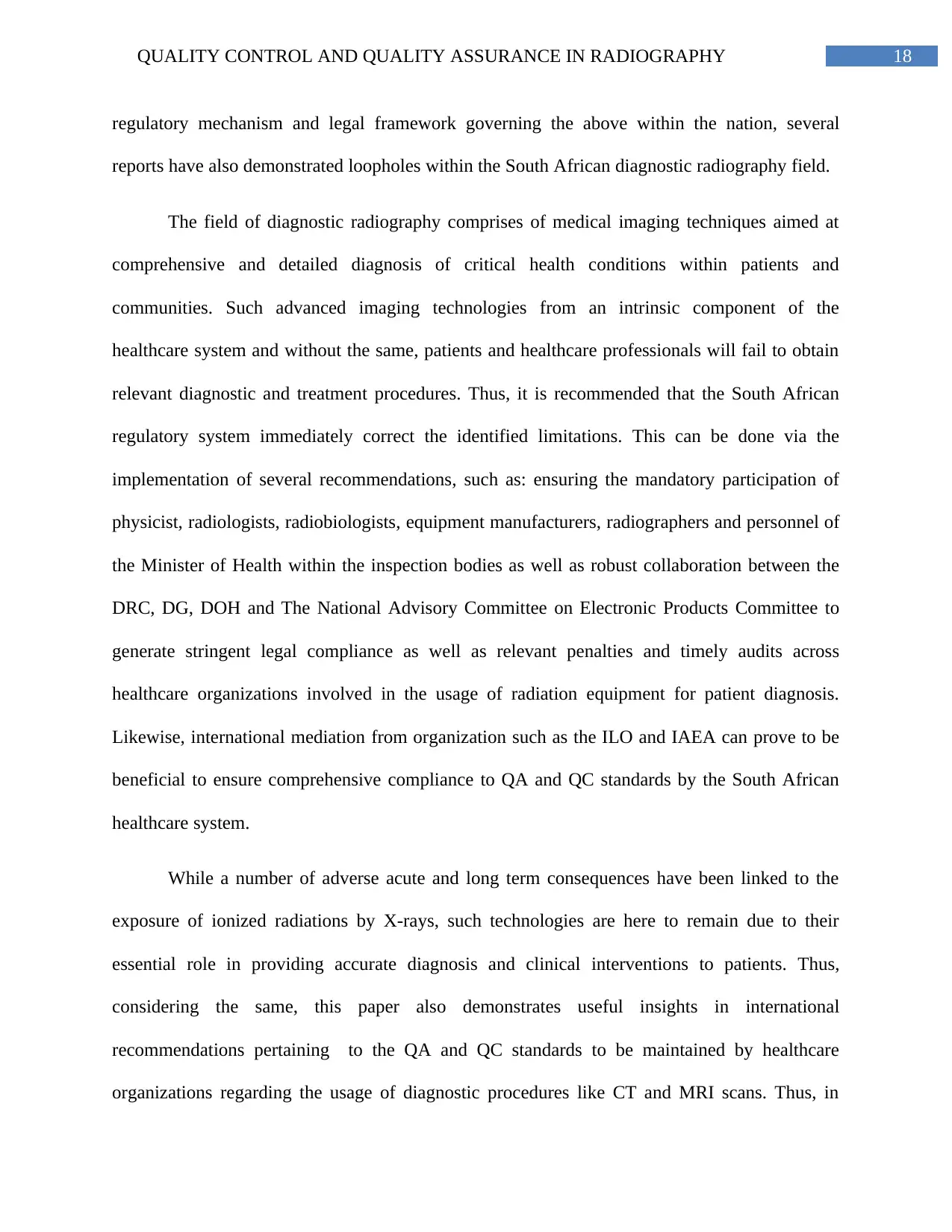
regulatory mechanism and legal framework governing the above within the nation, several
reports have also demonstrated loopholes within the South African diagnostic radiography field.
The field of diagnostic radiography comprises of medical imaging techniques aimed at
comprehensive and detailed diagnosis of critical health conditions within patients and
communities. Such advanced imaging technologies from an intrinsic component of the
healthcare system and without the same, patients and healthcare professionals will fail to obtain
relevant diagnostic and treatment procedures. Thus, it is recommended that the South African
regulatory system immediately correct the identified limitations. This can be done via the
implementation of several recommendations, such as: ensuring the mandatory participation of
physicist, radiologists, radiobiologists, equipment manufacturers, radiographers and personnel of
the Minister of Health within the inspection bodies as well as robust collaboration between the
DRC, DG, DOH and The National Advisory Committee on Electronic Products Committee to
generate stringent legal compliance as well as relevant penalties and timely audits across
healthcare organizations involved in the usage of radiation equipment for patient diagnosis.
Likewise, international mediation from organization such as the ILO and IAEA can prove to be
beneficial to ensure comprehensive compliance to QA and QC standards by the South African
healthcare system.
While a number of adverse acute and long term consequences have been linked to the
exposure of ionized radiations by X-rays, such technologies are here to remain due to their
essential role in providing accurate diagnosis and clinical interventions to patients. Thus,
considering the same, this paper also demonstrates useful insights in international
recommendations pertaining to the QA and QC standards to be maintained by healthcare
organizations regarding the usage of diagnostic procedures like CT and MRI scans. Thus, in
Paraphrase This Document
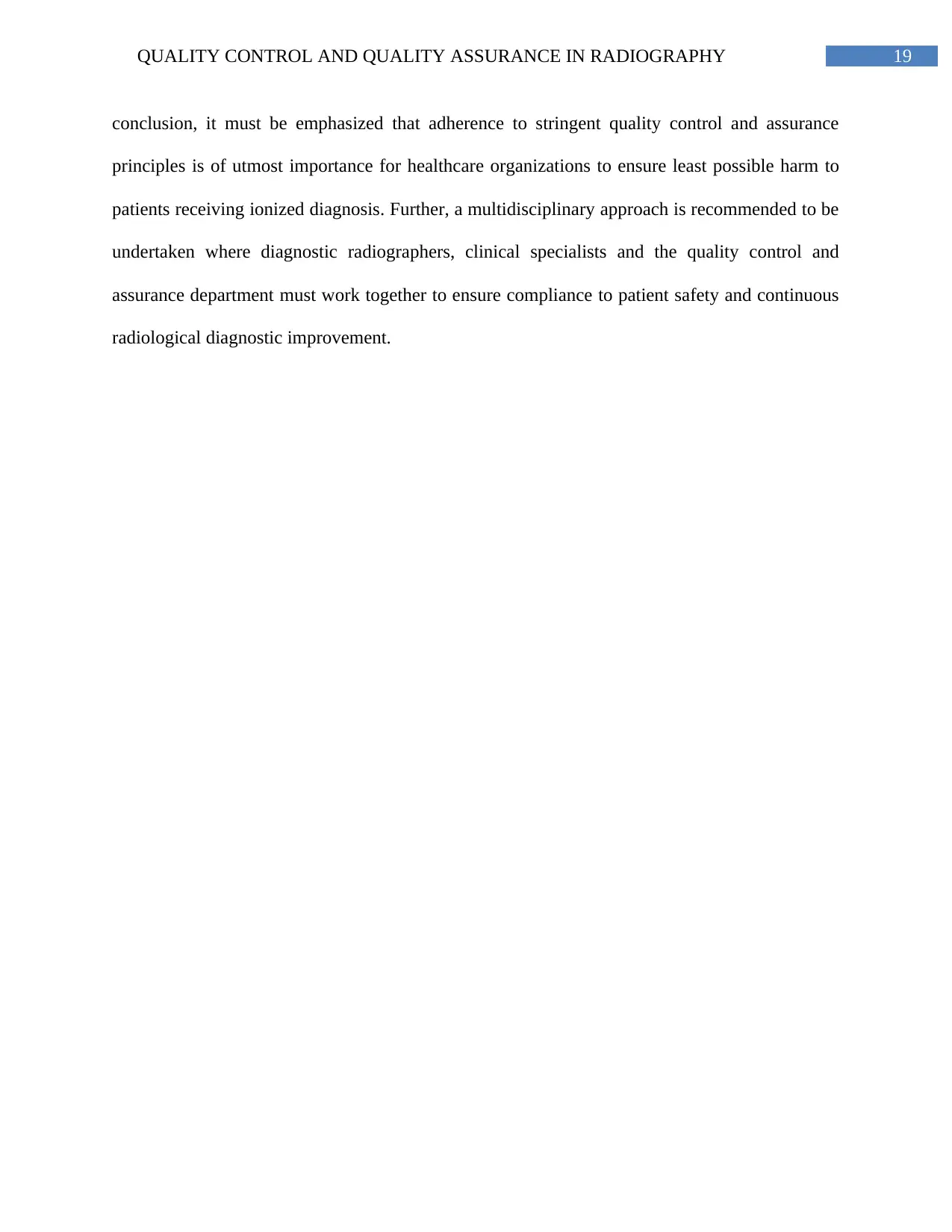
conclusion, it must be emphasized that adherence to stringent quality control and assurance
principles is of utmost importance for healthcare organizations to ensure least possible harm to
patients receiving ionized diagnosis. Further, a multidisciplinary approach is recommended to be
undertaken where diagnostic radiographers, clinical specialists and the quality control and
assurance department must work together to ensure compliance to patient safety and continuous
radiological diagnostic improvement.
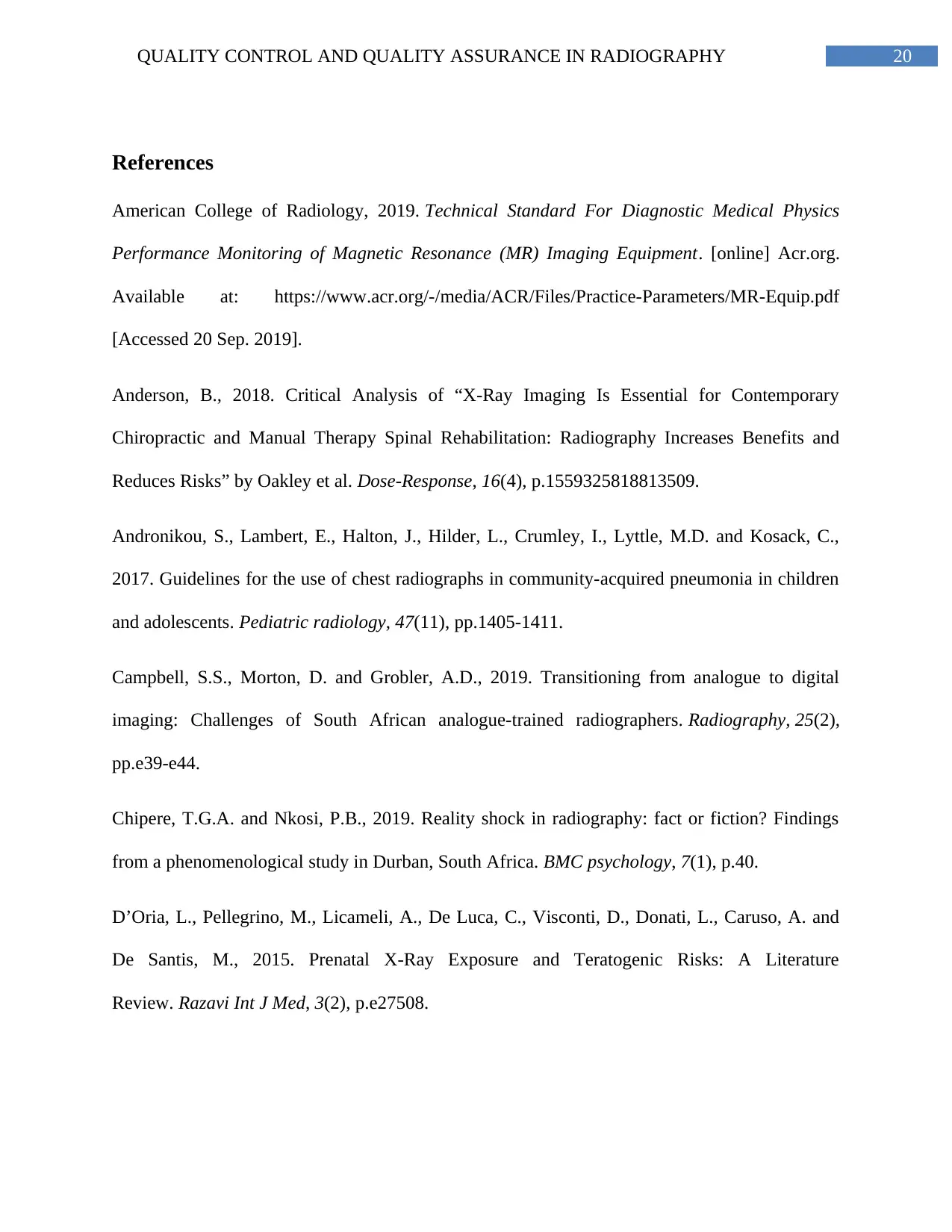
References
American College of Radiology, 2019. Technical Standard For Diagnostic Medical Physics
Performance Monitoring of Magnetic Resonance (MR) Imaging Equipment. [online] Acr.org.
Available at: https://www.acr.org/-/media/ACR/Files/Practice-Parameters/MR-Equip.pdf
[Accessed 20 Sep. 2019].
Anderson, B., 2018. Critical Analysis of “X-Ray Imaging Is Essential for Contemporary
Chiropractic and Manual Therapy Spinal Rehabilitation: Radiography Increases Benefits and
Reduces Risks” by Oakley et al. Dose-Response, 16(4), p.1559325818813509.
Andronikou, S., Lambert, E., Halton, J., Hilder, L., Crumley, I., Lyttle, M.D. and Kosack, C.,
2017. Guidelines for the use of chest radiographs in community-acquired pneumonia in children
and adolescents. Pediatric radiology, 47(11), pp.1405-1411.
Campbell, S.S., Morton, D. and Grobler, A.D., 2019. Transitioning from analogue to digital
imaging: Challenges of South African analogue-trained radiographers. Radiography, 25(2),
pp.e39-e44.
Chipere, T.G.A. and Nkosi, P.B., 2019. Reality shock in radiography: fact or fiction? Findings
from a phenomenological study in Durban, South Africa. BMC psychology, 7(1), p.40.
D’Oria, L., Pellegrino, M., Licameli, A., De Luca, C., Visconti, D., Donati, L., Caruso, A. and
De Santis, M., 2015. Prenatal X-Ray Exposure and Teratogenic Risks: A Literature
Review. Razavi Int J Med, 3(2), p.e27508.
⊘ This is a preview!⊘
Do you want full access?
Subscribe today to unlock all pages.

Trusted by 1+ million students worldwide
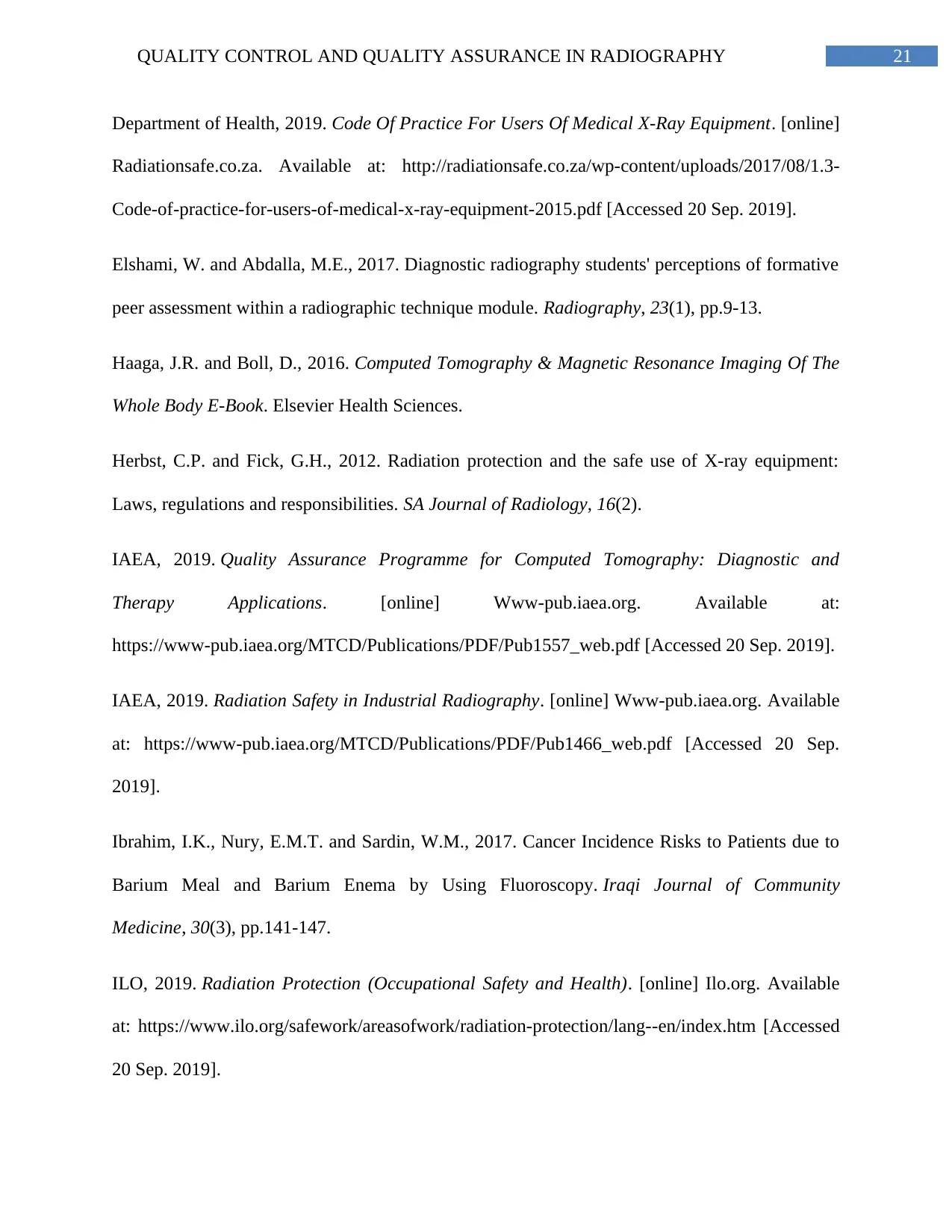
Department of Health, 2019. Code Of Practice For Users Of Medical X-Ray Equipment. [online]
Radiationsafe.co.za. Available at: http://radiationsafe.co.za/wp-content/uploads/2017/08/1.3-
Code-of-practice-for-users-of-medical-x-ray-equipment-2015.pdf [Accessed 20 Sep. 2019].
Elshami, W. and Abdalla, M.E., 2017. Diagnostic radiography students' perceptions of formative
peer assessment within a radiographic technique module. Radiography, 23(1), pp.9-13.
Haaga, J.R. and Boll, D., 2016. Computed Tomography & Magnetic Resonance Imaging Of The
Whole Body E-Book. Elsevier Health Sciences.
Herbst, C.P. and Fick, G.H., 2012. Radiation protection and the safe use of X-ray equipment:
Laws, regulations and responsibilities. SA Journal of Radiology, 16(2).
IAEA, 2019. Quality Assurance Programme for Computed Tomography: Diagnostic and
Therapy Applications. [online] Www-pub.iaea.org. Available at:
https://www-pub.iaea.org/MTCD/Publications/PDF/Pub1557_web.pdf [Accessed 20 Sep. 2019].
IAEA, 2019. Radiation Safety in Industrial Radiography. [online] Www-pub.iaea.org. Available
at: https://www-pub.iaea.org/MTCD/Publications/PDF/Pub1466_web.pdf [Accessed 20 Sep.
2019].
Ibrahim, I.K., Nury, E.M.T. and Sardin, W.M., 2017. Cancer Incidence Risks to Patients due to
Barium Meal and Barium Enema by Using Fluoroscopy. Iraqi Journal of Community
Medicine, 30(3), pp.141-147.
ILO, 2019. Radiation Protection (Occupational Safety and Health). [online] Ilo.org. Available
at: https://www.ilo.org/safework/areasofwork/radiation-protection/lang--en/index.htm [Accessed
20 Sep. 2019].
Paraphrase This Document
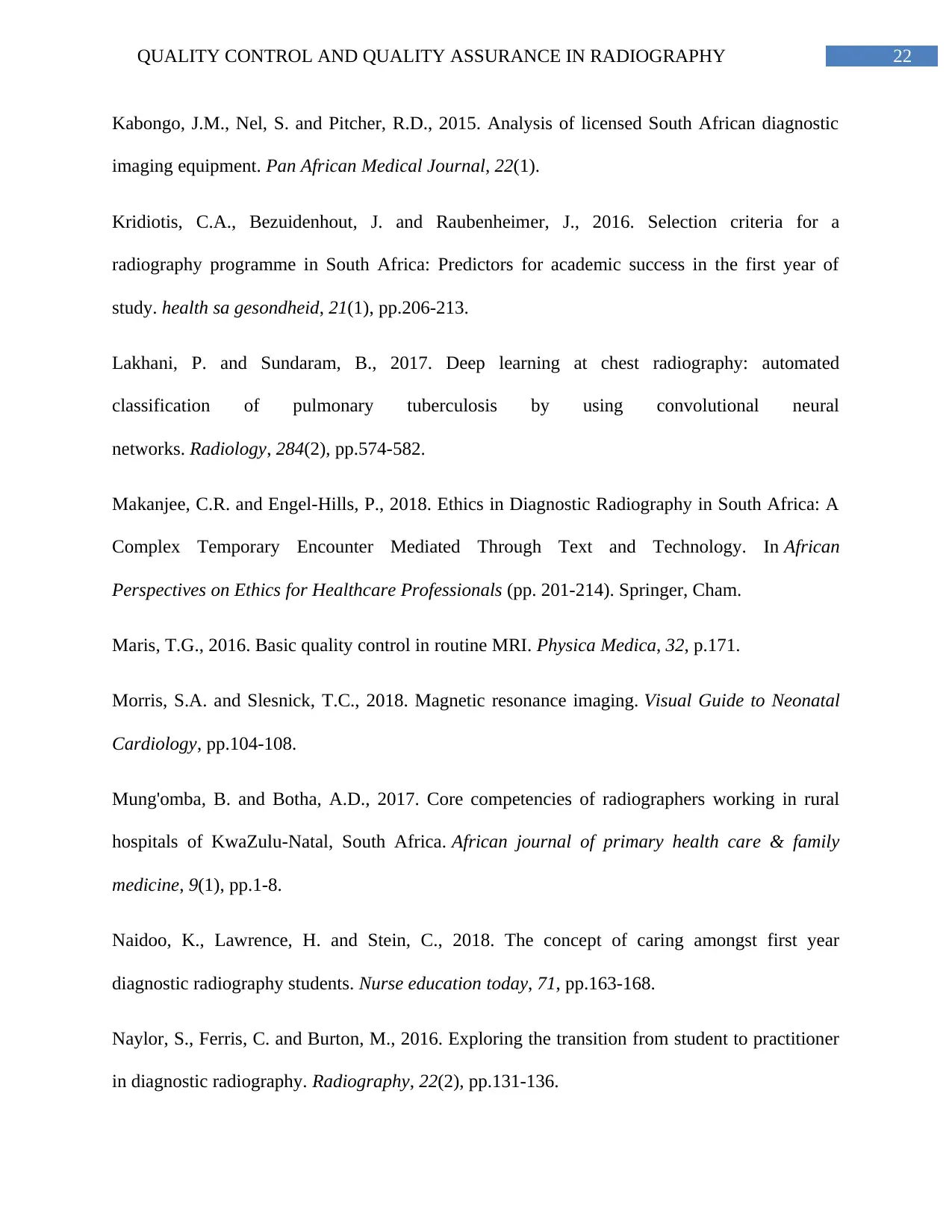
Kabongo, J.M., Nel, S. and Pitcher, R.D., 2015. Analysis of licensed South African diagnostic
imaging equipment. Pan African Medical Journal, 22(1).
Kridiotis, C.A., Bezuidenhout, J. and Raubenheimer, J., 2016. Selection criteria for a
radiography programme in South Africa: Predictors for academic success in the first year of
study. health sa gesondheid, 21(1), pp.206-213.
Lakhani, P. and Sundaram, B., 2017. Deep learning at chest radiography: automated
classification of pulmonary tuberculosis by using convolutional neural
networks. Radiology, 284(2), pp.574-582.
Makanjee, C.R. and Engel-Hills, P., 2018. Ethics in Diagnostic Radiography in South Africa: A
Complex Temporary Encounter Mediated Through Text and Technology. In African
Perspectives on Ethics for Healthcare Professionals (pp. 201-214). Springer, Cham.
Maris, T.G., 2016. Basic quality control in routine MRI. Physica Medica, 32, p.171.
Morris, S.A. and Slesnick, T.C., 2018. Magnetic resonance imaging. Visual Guide to Neonatal
Cardiology, pp.104-108.
Mung'omba, B. and Botha, A.D., 2017. Core competencies of radiographers working in rural
hospitals of KwaZulu-Natal, South Africa. African journal of primary health care & family
medicine, 9(1), pp.1-8.
Naidoo, K., Lawrence, H. and Stein, C., 2018. The concept of caring amongst first year
diagnostic radiography students. Nurse education today, 71, pp.163-168.
Naylor, S., Ferris, C. and Burton, M., 2016. Exploring the transition from student to practitioner
in diagnostic radiography. Radiography, 22(2), pp.131-136.
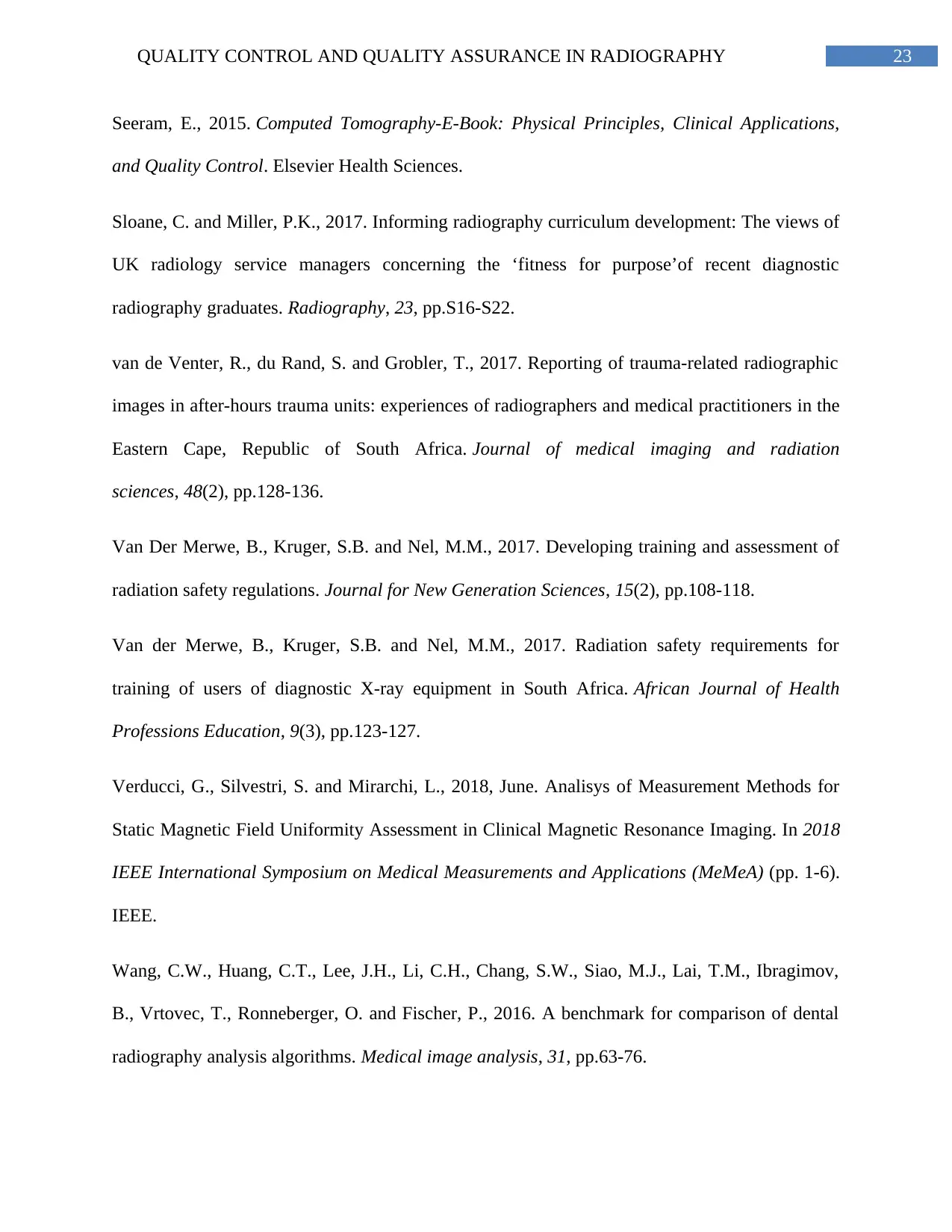
Seeram, E., 2015. Computed Tomography-E-Book: Physical Principles, Clinical Applications,
and Quality Control. Elsevier Health Sciences.
Sloane, C. and Miller, P.K., 2017. Informing radiography curriculum development: The views of
UK radiology service managers concerning the ‘fitness for purpose’of recent diagnostic
radiography graduates. Radiography, 23, pp.S16-S22.
van de Venter, R., du Rand, S. and Grobler, T., 2017. Reporting of trauma-related radiographic
images in after-hours trauma units: experiences of radiographers and medical practitioners in the
Eastern Cape, Republic of South Africa. Journal of medical imaging and radiation
sciences, 48(2), pp.128-136.
Van Der Merwe, B., Kruger, S.B. and Nel, M.M., 2017. Developing training and assessment of
radiation safety regulations. Journal for New Generation Sciences, 15(2), pp.108-118.
Van der Merwe, B., Kruger, S.B. and Nel, M.M., 2017. Radiation safety requirements for
training of users of diagnostic X-ray equipment in South Africa. African Journal of Health
Professions Education, 9(3), pp.123-127.
Verducci, G., Silvestri, S. and Mirarchi, L., 2018, June. Analisys of Measurement Methods for
Static Magnetic Field Uniformity Assessment in Clinical Magnetic Resonance Imaging. In 2018
IEEE International Symposium on Medical Measurements and Applications (MeMeA) (pp. 1-6).
IEEE.
Wang, C.W., Huang, C.T., Lee, J.H., Li, C.H., Chang, S.W., Siao, M.J., Lai, T.M., Ibragimov,
B., Vrtovec, T., Ronneberger, O. and Fischer, P., 2016. A benchmark for comparison of dental
radiography analysis algorithms. Medical image analysis, 31, pp.63-76.
⊘ This is a preview!⊘
Do you want full access?
Subscribe today to unlock all pages.

Trusted by 1+ million students worldwide
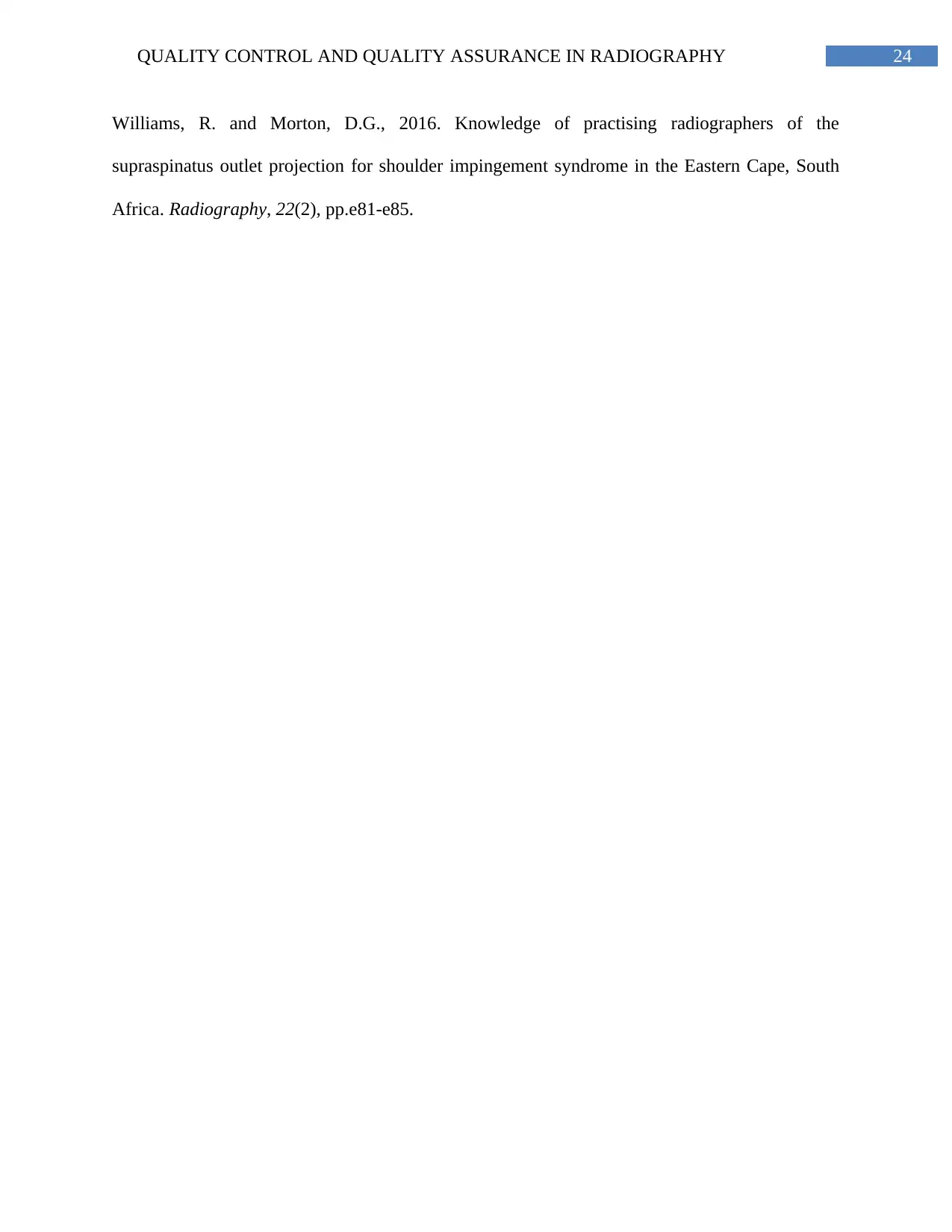
Williams, R. and Morton, D.G., 2016. Knowledge of practising radiographers of the
supraspinatus outlet projection for shoulder impingement syndrome in the Eastern Cape, South
Africa. Radiography, 22(2), pp.e81-e85.
Related Documents
Your All-in-One AI-Powered Toolkit for Academic Success.
+13062052269
info@desklib.com
Available 24*7 on WhatsApp / Email
![[object Object]](/_next/static/media/star-bottom.7253800d.svg)
© 2024 | Zucol Services PVT LTD | All rights reserved.





